| | | | | | |
| | | | | | |
|
View Coin
| J-119 |
United States
|
1C 1850 J-119
|
PCGS PF 63
|

1850 1C
J-119 Original, Pollock-134
Rarity: Low R.6 PR63
Struck in billon (10% silver, 90% copper) with a plain edge and medal turn.
The annular cent pattern, with a largish hole in the middle. It is interesting to note that Judd describes the obverse in the convention manner, as the side with the date, while Pollock reverse the sides.
Obverse: displays the denomination CENT at the top, the date 1850 is at the bottom, two rosettes are on each side, and a perforation in the center. It is interesting to note that Judd describes the obverse in the convention manner, as the side with the date, while Pollock reverse the sides.
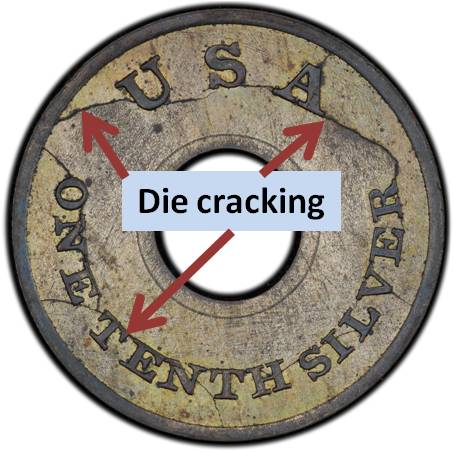 Reverse: USA inscribe at the top and "ONE TENTH SILVER" around at the bottom. It is curious the the U is not parallel to the rim on the inscription of USA. In the striking process of shattering and this piece shows the heavy die cracks that resulted. Reverse: USA inscribe at the top and "ONE TENTH SILVER" around at the bottom. It is curious the the U is not parallel to the rim on the inscription of USA. In the striking process of shattering and this piece shows the heavy die cracks that resulted.
Comment: Gray patina is seen over each side with bright, underlying silver-rose surfaces. A lovely example
With this pattern the Mint thought that a copper cent with a trace of silver, and in small diameter, could be produced to yield a profit. A problem with billon, was that the users of such coins had no way to notice the silver alloy, making them easy to counterfeit cheaply. Further, the making "holey" coins was a clumsy procedure.
Moreover, several years later on May 26, 1854, James Ross Snowden, then director of the Mint (since 1853), wrote to Secretary of the Treasury James Guthrie, noting that when eventually such billon pieces were redeemed after use, the cost of recovering the silver would exceed the value the silver metal obtained. Further: "The mechanical difficulties in making ring cents are not trivial. They lie not in planchet cutting but in stamping in ejecting the coin from the dies. I estimate that most of the value of a cent so formed would be sunk in the cost of striking."
Provenance/ Appearances:
Heritage Oct 2016 - Dallas / Lot #3963
|

|
|
View Coin
| J-124 |
United States
|
1C 1850 J-124
|
PCGS PF 64
|
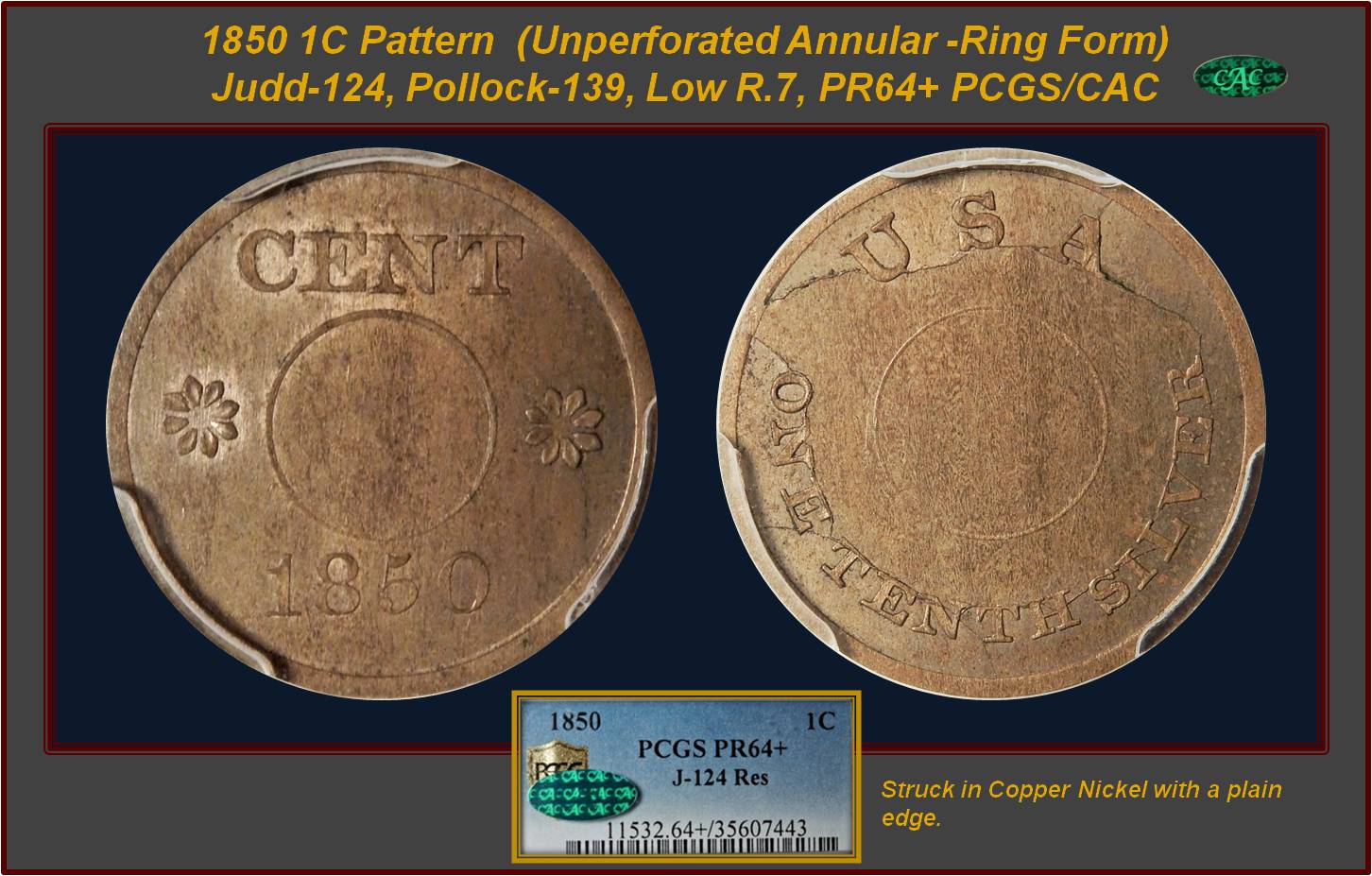
1850 P1C One Cent
Judd-124 Restrike, Pollock-139 --- same as the J-119 but without the perforation.
Rarity: Low R.7, PR64 + CAC Endorsed
Ex: Lumus
Struck in copper-nickel with a plain edge
Obverse: : CENT above place for undrilled hole, 1850 is beneath, floret are to either side of the unpunched hole.
Reverse: “USA” arcs above space for undrilled hole, and “ONE TENTH SILVER” curves below. Extensive die breaks on the reverse.
Comment: An experiment in producing a smaller-size cent piece, one intended, of course, to be produced in silver with a central perforation to lower the weight and corresponding silver content. The originals were produced in billon (90% copper, 10% silver), with weights from 24 to 26 grains, but they were too subject to counterfeiting, among other difficulties with the issue.
indicate the
The piece is is a Light gray-rose color covering both sides, with some minor flecks noted on both sides but nonetheless attractive. The reverse (ONE TENTH SILVER) side shows extensive peripheral die breaking through the legends. The die apparently shattered early during the striking of the original restrike status of this piece, of which only a half dozen or so are known.
Provenance/Appearance:
Private sale June 2019; Prior
|

|
|
View Coin
| J-127 |
United States
|
1C (1851) J-127
|
PCGS MS 64
|

(1851) ONE TENTH
Judd-127 Original, Pollock-149,
Rarity: Low R.6; MS64
Struck in billon (10% silver, 90% copper) with a plain edge.
Obverse: Features CENT at the top and ONE TENTH SILVER at the bottom, Struck in 1851 these pieces are dateless
Reverse: Reverse depicts a laurel wreath and the legend UNITED STATES OF AMERICA.
Comment
Part of an effort to reduce the diameter of the cumbersome large cent but these were most likely struck just to test the materials as perforations was abandon in the prior year. This piece is center perforated, unlike restrikes.
The surfaces are hazy gray and there is a planchet lamination across much of the obverse. Sharply defined and otherwise well struck. Billion must be difficult to classify as Proof but no articles indicated a "Business Strike" for the J-127 even though PCGS has slabbed a couple J-127's as MS vs a proof designation
Provenance/ Appearances:
Heritage Aug 2017 ANA Auction - Denver / Lot #5393
|

|
|
View Coin
| J-151 |
United States
|
1C 1853 J-151
|
PCGS PF 62
|

1853 E1C One Cent
Judd-151, Pollock-178
Rarity: Low R.6, PR62 CAC Endorsed
Struck in Copper Nickel ( believed 40% Nickel / 60% copper) with Reeded Edge
Obverse: Liberty Head with 13 stars - same as regular issue 1853 Quarter Eagle
Reverse: The denomination of "One Cent" within a laurel wreath.
Comment:
This pattern issue combines the obverse of 1853 quarter eagles with a new reverse inscribed ONE CENT. Composition was copper-nickel alloy similar to the “German silver” alloy used by Lewis Feuchtwanger for his private cent patterns of 1837. This alloy combined copper, nickel, and zinc in various proportions.
Three such compositions were recorded:
40% copper, 40% nickel, 20% zinc;
30% nickel, 60% copper, 10% zinc; and
40% nickel, 60% copper.
Although each composition had its own inherent coloration, practical considerations suggest these cannot easily be distinguished by color alone. Specific gravity of these compositions do not provide the necessary distinction.
This piece is a lovely Pewter gray, with light striated toning visible on both sides. Some underlying reflectivity in the fields. A scratch is noted along Liberty's throat, but is not likely to be noticed without magnification.
Provenance/Appearances:
Purchased from Park Avenue Mar 2015; From the 1853 Collection. Stacks and Bowers Oct 2014 Winter Baltimore Sale/ Lot #1058, Prior Purchased privately from South Miami Rare Coins, Feb 1991.
|

|
|
View Coin
| J-159a |
United States
|
1C 1854 J-159a
|
PCGS PF 64 Brown
|
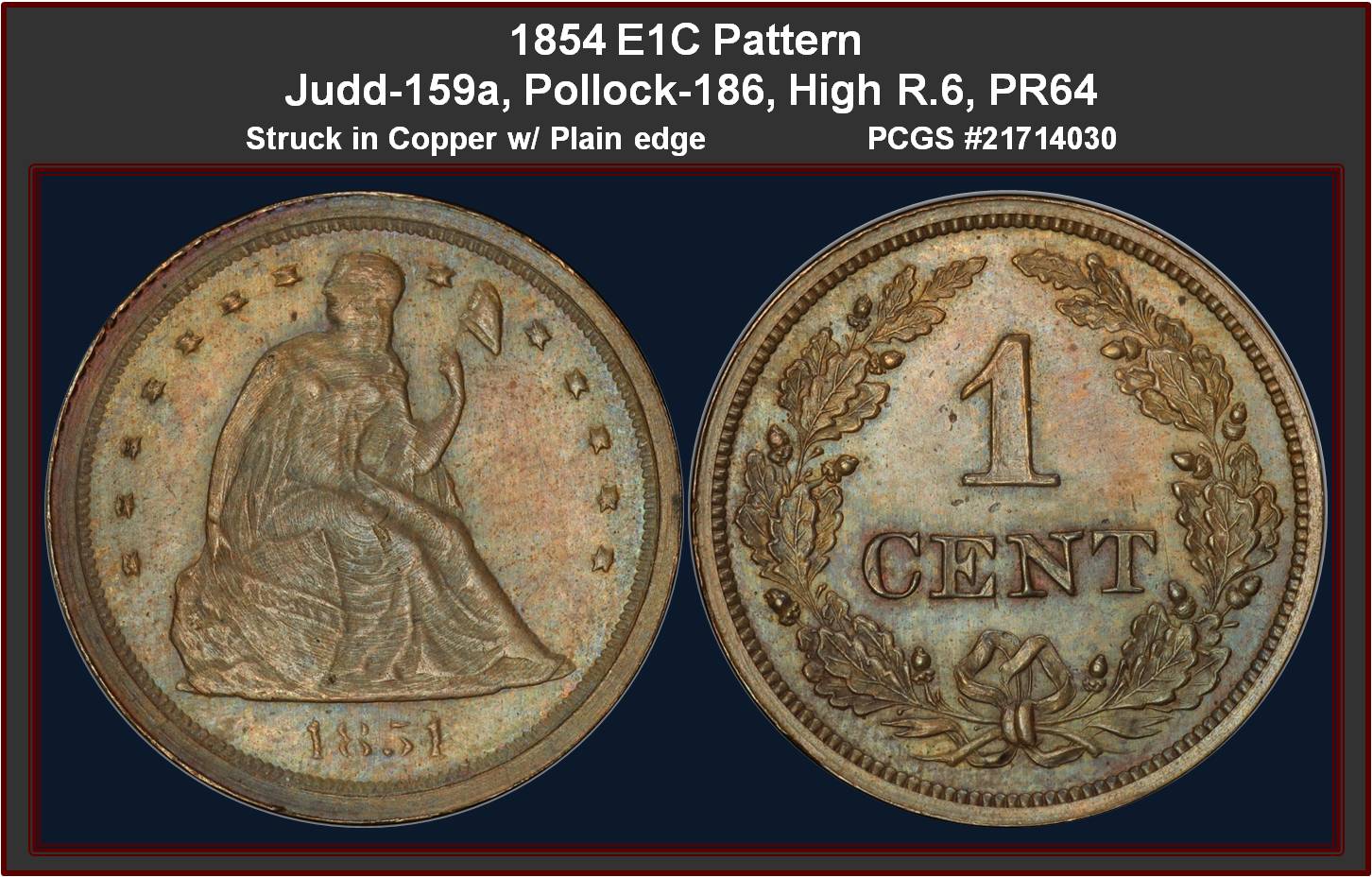
1854 1C
Judd-159a, Pollock-186,
Rarity: High R.6, PF64
Struck in copper with a plain edge.
Obverse: Gobrecht's Liberty Seated motif, as seen on the circulating silver issues of the era, 13 thin, attenuated stars around Liberty, date below.
Reverse: 1 CENT within open-topped wreath of oak leaves and acorns, bow at bottom of wreath.
Comment: An unusual pattern variety. The obverse die was made by crudely reducing an 1854 silver dollar with a lathe, causing prominent concentric die lines and blurry design details. The date resembles 1851. The reverse shows 1 CENT encircled by an oak and acorn wreath. The while the die struck Judd-159 is a formidable rarity (two or three known) but its electrotype copper counterpart Judd-159a is somewhat more available but not by much with only 13 - 20 pieces believed to exist. 
The original holder the edge was obscured by the encapsulation, which made it impossible to confirm the seam that distinguishes Judd-159a from Judd-159 was there. After having it re-holder PCGS confirmed it was a Judd-159. It was not until the 8th Edition of Judd reference book that the 2 different varieties were separated. Both sides exhibit a wire rim, especially steep on the obverse near 11 o'clock.
A sea-green and tan-brown near-Gem with a few tiny flan flaws on the central reverse.
Provenance/Appearances:
From The Tom & Jean Fore Collection. Heritage Jan 2016 - Tampa / Lot #6272;
Prior
- Dallas Signature (Heritage, 12/2004), lot 6346;
- Heritage Jan 29, 2005 Continuous Internet Auction / Lot #23425;
- Sherman's Obsessive Compulsive Collection, Stacks June 2010 Baltimore / Lot 3396;
- Stacks August 2011 Chicago ANA / Lot 9003;
|

|
|
View Coin
| J-160 |
United States
|
1C 1854 J-160
|
PCGS PF 64 Brown
|

1854 1C
Judd-160, Pollock-187
Rarity: R.4; PF64BN
From the Lux Family Collection, begun as early as the 1850s.
Struck in Copper with Plain Edge
Obverse: : The usual head of Liberty facing left from the contemporary large cent design, with the date below. No other design elements are present, so the effect is a pleasing cameo. The diameter is slightly smaller than the contemporary regular issue large cent.
Reverse: : An exact copy of the current large cent, however the design elements are not only smaller for the reduced size of the coin, but the size of the lettering and wreath are also smaller, producing a more elegant ensemble. Thus the wreath is compact and the letters are more finely executed.
Comment: : This is an attractive Choice specimen that exhibits dominant medium brown patina with glints of original faded orange luster persisting, more so on the reverse than the obverse. Sharply struck overall and pleasingly smooth.
Provenance/Appearances: :
Stacks and Bowers March 2021 Auction - Session 5 / Lot 5596; From the Lux Family Collection, that began as early as the 1850s.
|

|
|
View Coin
| J-161 |
United States
|
1C 1854 J-161
|
PCGS PF 63 Brown
|

1854 1C
Judd-161, Pollock-187
Rarity: R.4 Original; PF63BN
Struck in Bronze with Plain Edge
Obverse: : The usual head of Liberty facing left from the contemporary large cent design, with the date below. No other design elements are present, so the effect is a pleasing cameo. The diameter is slightly smaller than the contemporary regular issue large cent.
Reverse: An exact copy of the current large cent, however the design elements are not only smaller for the reduced size of the coin, but the size of the lettering and wreath are also smaller, producing a more elegant ensemble. Thus the wreath is compact and the letters are more finely executed.
Comments:
Lovely struck large Cent with nice bright brown surfaces.
This design the same as the J-160 above - Pollock did not assign a unique reference number between these Judd samples as he believed you can not distinguish without a metallurgic testing.
Provenance/Appearances: :
From ANA Money Show 2005 Atlanta, Prior Heritage Aug 2004 - Pittsburgh, PA Signature Sale / Lot #7880
|

|
|
View Coin
| J-164 |
United States
|
1C 1854 J-164
|
PCGS PF 65 Brown
|

1854 1C Flying Eagle
Judd-164 Original, Pollock-189
Rarity: R.5, PR65 BN
Struck in bronze with a plain edge.
Obverse: Flying Eagle design with a hook-neck eagle on the obverse, surrounded by stars and the date below.
Reverse: Closely resembles the regular dies issue for the large cent. A continuous wreath with ribbon at bottom. 2 leaves at under the E (of States). 2 other rarer reveres varieties exists with different # of Leaves
Comments:
US patterns.com states that Originals are said to be from 90 to 100 grains with re-strikes weighing about 113 grains.
A pleasing wood grain effect is noted on the obverse, while uniform chocolate-brown color prevails on the reverse.
Provenance/Appearance:
Private sale with Ric Snow; Prior Heritage Spt 2016 Long Beach Signature Auction / Lot #5866; Heritage Feb 2002 Long Beach Signature Auction/ Lot #7270
|

|
|
View Coin
| J-168 |
United States
|
1C 1855 J-168
|
NGC PF 61 BN
|
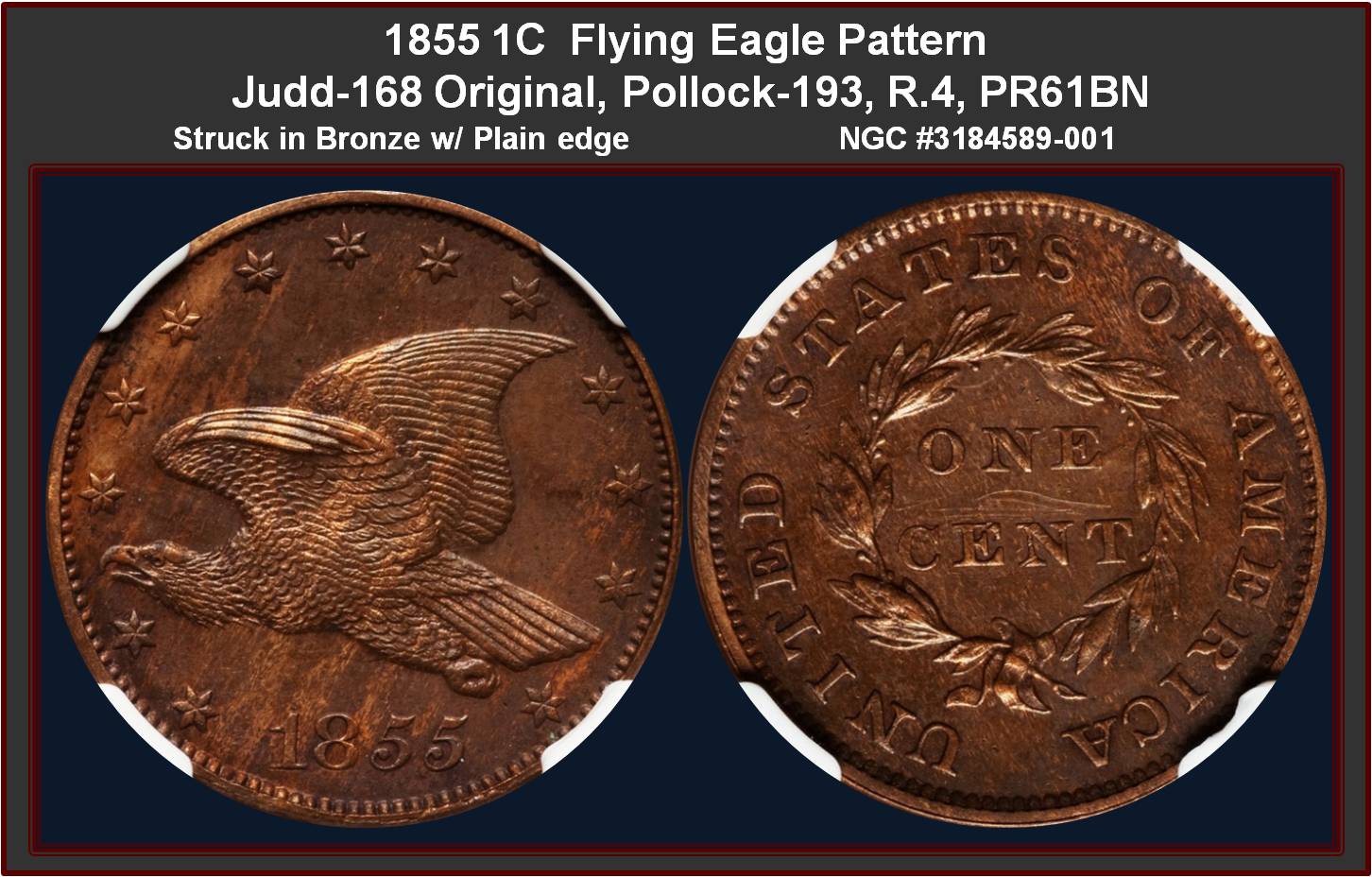
1855 1C Large Cent Flying Eagle
Judd-168, Pollock-193
Rarity: R.4; PF61BN
Struck in bronze with a plain edge.
Obverse: The large cent version of the flying eagle was designed with 13 stars surround an eagle.
Reverse: Similar to the 1855 large cent. The diameter is smaller than the large cents but larger than the small flying eagles that were officially adopted in 1857.
Comment:
This coin is similar to the Christian Gobrecht/Titian Peale flying eagle design for the Gobrecht dollars (and soon the Flying Eagle cents).
The planchet shows streaks ( actually attractive), as often seen on this pattern. A few pin scratches are seen between ONE and CENT on the reverse.
Provenance/Appearances:
Heritage Oct 2011 Signature Auction- Pittsburgh / Lot #4543
|

|
|
View Coin
| J-170a |
United States
|
1C 1855 J-170a
|
PCGS PF 64
|
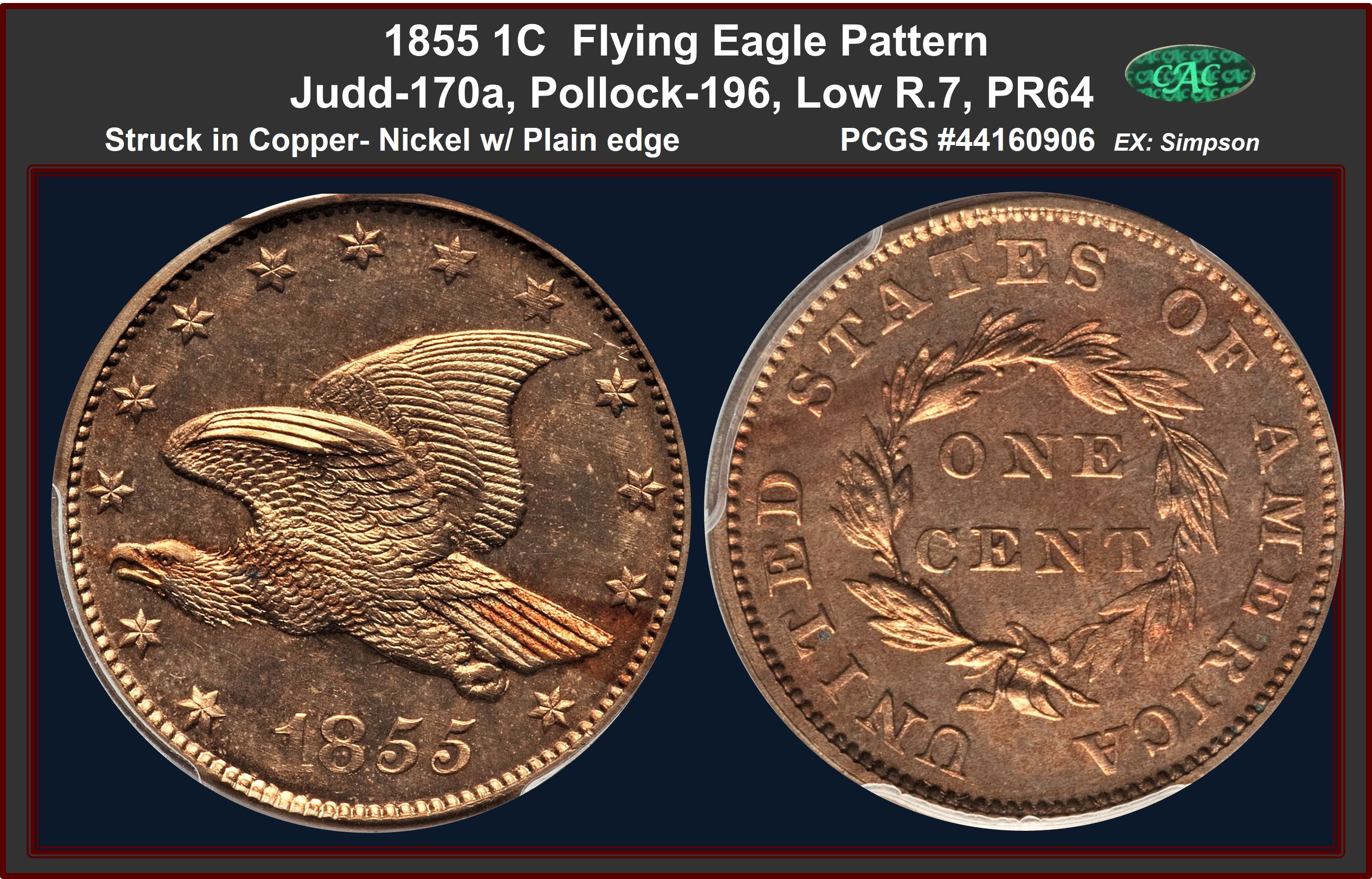
1855 1C Flying Eagle Cent,
Judd-170a, Pollock-196
Rarity: Low R.7, PR64 CAC Endorsed
Ex: Simpson.
Struck in copper-nickel with a plain edge.
Obverse: Thirteen stars surround an eagle that is flying slightly upward, similar to the Christian Gobrecht/Titian Peale flying eagle design for the Gobrecht dollars (and soon the Flying Eagle cents). ‘
Reverse: The reverse design is similar to the issued large cent.
Comment:
 The diameter is intermediate between the large cents struck for commerce in 1855 and the small cents that were first produced in 1856 These still represent a still-to-be-discovered metallurgical variants. The major variants include copper/bronze, oroide, various compositions of copper-nickel, German silver, and pure nickel. The diameter is intermediate between the large cents struck for commerce in 1855 and the small cents that were first produced in 1856 These still represent a still-to-be-discovered metallurgical variants. The major variants include copper/bronze, oroide, various compositions of copper-nickel, German silver, and pure nickel.
The surfaces of this piece display the expected bright yellow-tan appearance of the nickel alloy with occasional streaks of red on each side.
Is is believed to be Copper-nickel 90% copper and 10% nickel
This piece was also the Plate coin image included in the article by Rick King in the April 23, 2023 The Numismatist
magazine on the subject of the mints experimentation with different metal compositions.
Provenance/ Appearances:
Ex Simpson, Heritage May 2022 CSNS / Lot #3633
|

|
|
View Coin
| J-177 |
United States
|
1/2C 1856 J-177
|
PCGS MS 63
|
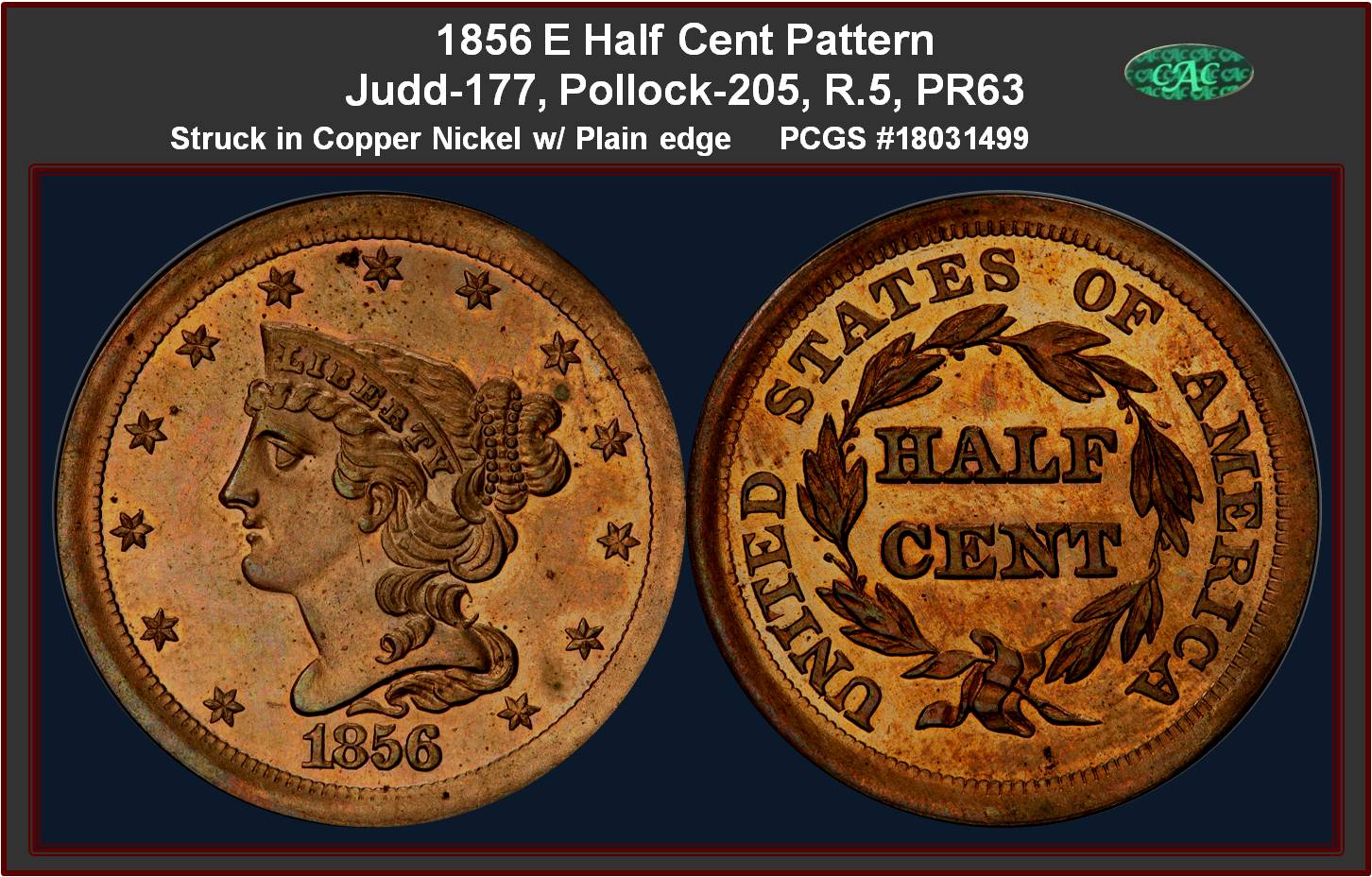
1856 Half Cent
Judd-177, Pollock-205
Rarity: R.5, PR63 Endorsed by CAC.
Struck in copper-nickel with a plain edge.
Obverse/Reverse: Regular dies for the Braided Hair half cent,
Comment:
These metallurgical trial strikes were produced in anticipation of the Flying Eagle small cents that began production the same year.
This example is a lovely Select proof with lightly mirrored, golden-tan surfaces. A few hairlines and contact marks are insignificant.
Additional Information noted the Harry Bass site on these 1/2 cents:
"Essentially an experimental issue to test the copper-nickel alloy, this pattern was struck from the regular dies catalogued as Breen-2 among half cents of this year. Two different compositions are reported, one with 90% copper and 10% nickel, the other with 88% copper and 12% nickel. Although some numismatists have attempted to distinguish between these compositions based on color, the only way to be certain is through elemental analysis. These half cent patterns were struck sometime prior to July 11, 1856, the date of a letter from the Mint Director to Secretary of the Treasury James Guthrie."
Additional Information noted the Stacks and Bowers Catalog notation in the Nov 2010 75th Anniversary Sale
The increase in Nickel usage was partly driven by Joseph Wharton who was a wise businessman who saw an opportunity of mining. The metal nickel was of little use at the time, and he purchased the nickel mines then existing in the Western hemisphere. Soon Wharton had the ears of important politicians and nickel soon became a metal of design for the mint to use. The hardness of nickel meant that it lasted a very long time in circulation; however, the dies were scarcely able to strike it up without shattering. By combining nickel with copper or other metals, the mints were able to employ it as a planchet ingredient on several small denomination coins. Wharton eventually became rich selling his nickel supplies to the mints for coinage and donated money to form the Wharton Business school located at the University of Pennsylvania
Provenance/Appearances
From The Dale Hopkins Collection; 2014 April 23 - 27 CSNS US Coin Signature Auction - Chicago #1204; Prior Stacks Nov. 2010, 75th Anniversary Sale -The W.L. Carson Collection of U.S. Proof Sets THE COINS OF 1856 /Lot# 5006
.
|

|
|
View Coin
| J-180 |
United States
|
1C 1856 EAGLE
|
PCGS PF 63
|

One Cent Flying Eagle
Judd-180, Pollock P-212
Rarity: R.2 PR63 CAC Endorsed
Struck in copper Nickel with plain Edge
Obverse: A eagle in flight to the left with UNITED STATES OF AMERICA above and the date below.
Reverse: The denomination "ONE CENT" within an agricultural wreath of corn, wheat,cotton and tobacco leaves.
In Pollock this is the reverse type "B" diagnostic by "E" in CENT is open and "E" in ONE is closed combined with the tip of of the leaf is above the base of the "C" and the tip of the leaf near the "T" is well below the base of the "T"
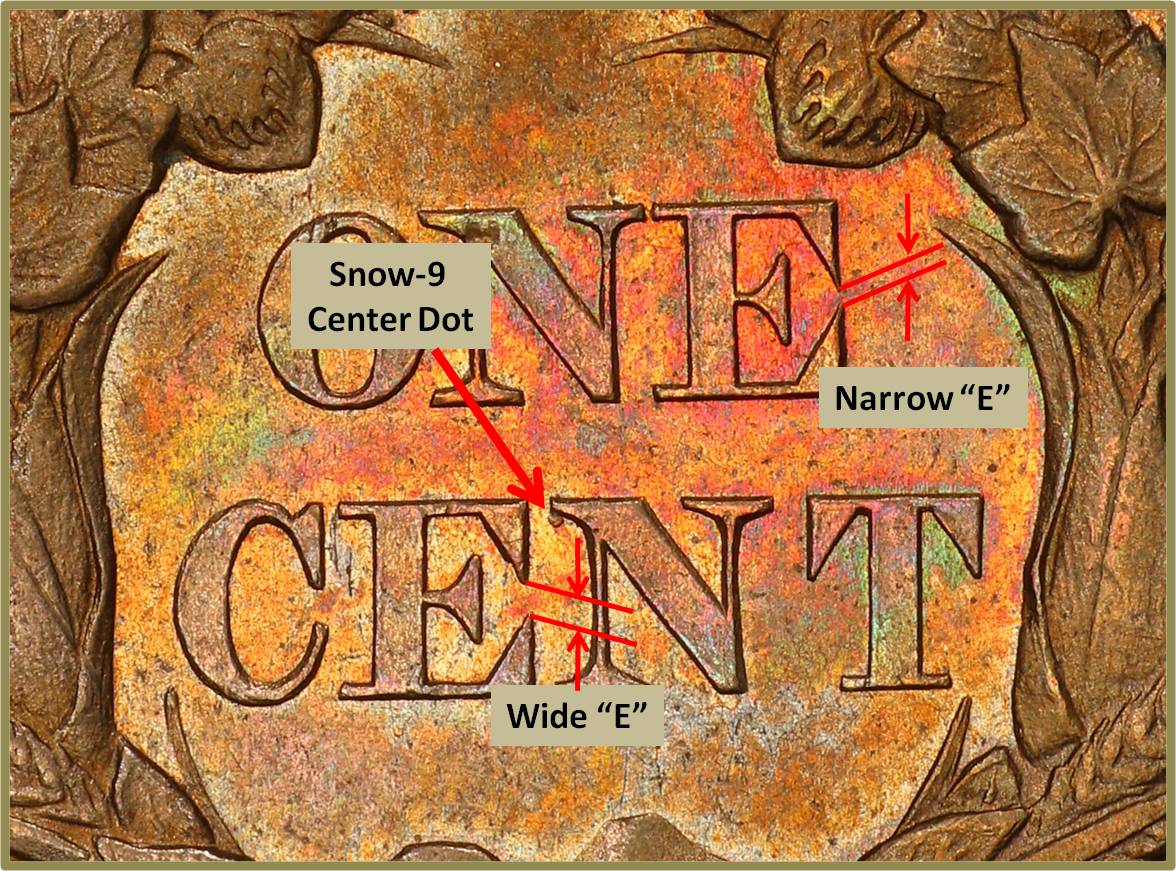 Comment: Comment:
Richard Snow outlines nicely the 1856 history in “A guide Book of Flying Eagle and Indian Head Cents”. It appeared the 1st batch of patterns were struck in Mint State and freely exchange hands within the government with hundreds of samples and most likely many made their way into circulation. After the 1857 Eagle production started and release collectors became interested in finding 1856 pieces. The mint director ordered additional Proof formats minted in 1858 . The Snow -9 Center Dot is the diagnostic for these “RESTRIKE” proof versions
|

|
|
View Coin
| J-184 |
United States
|
1C 1856 J-184
|
PCGS PF 62
|
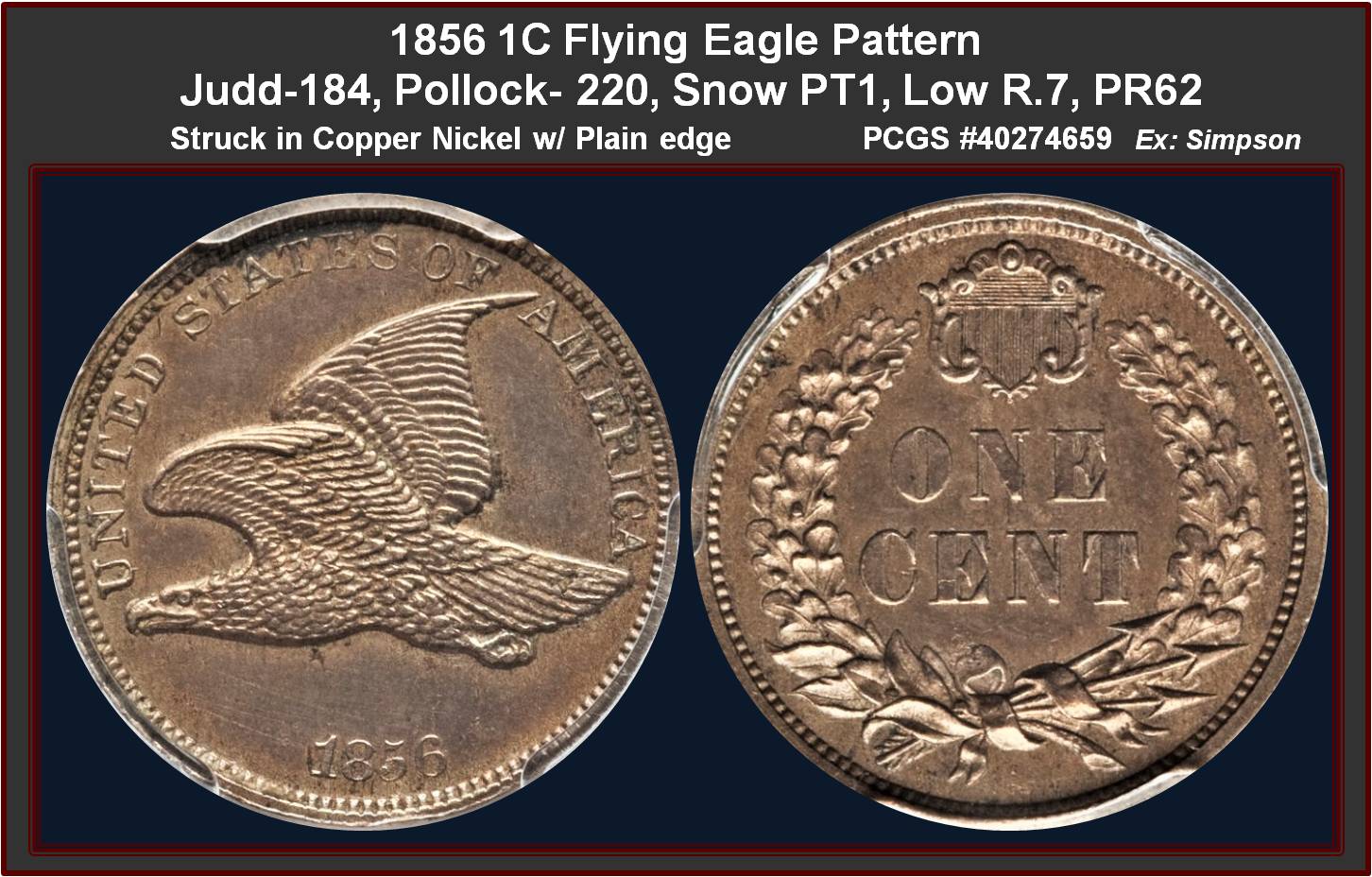
1856 1C Flying Eagle
Judd-184 Pollock-220, Snow-PT1,
Rarity: Low R.7. PF62
Ex: Simpson
Struck in copper-nickel with a plain edge.
Obverse: Was struck from the normal 1856 Flying Eagle cent dies, showing a flying eagle in a plain field with the legend UNITED STATES OF AMERICA and the date below. The O in OF is squared-off.
Reverse: Exhibits an oak wreath with ornamental shield above and the denomination ONE CENT in the center -- a design vaguely presaging the regular-issue reverse with shield and oak wreath of the 1860-1909 Indian cents.
Comment:
The dies correspond to Rick Snow's Die Pair 2, without a line below the amulets on the left side of the shield. Snow writes that probably not more than 25 Judd-184 representatives were struck at some point between 1856 and 1858. This PR62 example is tan-gold with violet, steel, and peach-orange accents. A couple of stray marks appear over the date.
Provenance/Appearances:
From Bob Simpson Collection Part 3, Heritage Jan 2021 Signature Auction / Lot #3074; Priors"
- Heritage Jan 1994 F.U.N. Bullet Sale #115 / Lot #1061;
- Bowers & Merena Jan 1985 / Lot #494
|

|
|
View Coin
| J-191 |
United States
|
1C 1858 J-191
|
PCGS PF 64
|

1858 1C Flying Eagle
J-191, Pollock-233, Snow-PT14a, Snow Die Pair II.
Rarity: R.5. PF64; CAC Endorsed & Eagle Eye Photo Seal.
Struck in Copper-Nickel with a Plain Edge
Obverse: The regular issue 1858 Flying Eagle cent die, Small Letters.
Reverse: Laurel wreath design, nearly the sane that as adopted for use on the Indian cent of 1859, but with clusters of five leaves instead of six. This is the more common of the dies variety.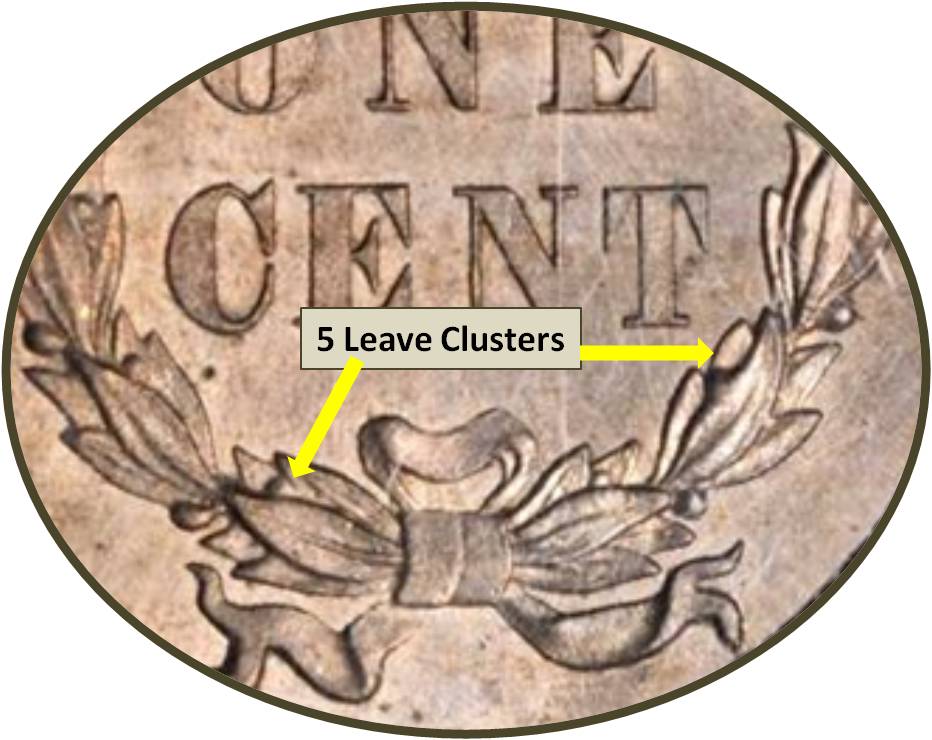
Comment:
Sharply struck on both sides, this pattern Flying Eagle cent is splendid and beautiful in every respect. Both sides retain noticeable amounts of the original "white" surface from the higher nickel alloy. Additionally a slight overlay of reddish patina is seen over each side, a bit deeper in hue on the reverse. The fields are deeply reflective as well, undoubtedly from the lack of any significant color.
This is one of the 12 1858 1c pieces part of the pattern sets distributed to Congress.
Provenance/Appearances:
Stacks and Bowers Nov 2016 Baltimore-Session 6 /Lot 4597; prior Provenance: From the Hoosier Flyer Collection Stacks Aug 2012 Philadelphia ANA /Lot 11207; Heritage Dec 2009 Houston / Lot #1452
|

|
|
View Coin
| J-192 |
United States
|
1C 1858 J-192
|
PCGS PF 64
|

1858 1c Flying Eagle
Judd-192, Pollock-235, Snow-PT13
Rarity: R.5, PF64, CAC Endorsed and Photo Seal Endorsement
Struck in copper-nickel with a plain edge
Obverse is the familiar Small Letters 1858 cent.
Reverse Generally resembles the 1860 regular issue reverse, but there is no shield at the top and the closed oak wreath.Three arrows and olive sprig at the base of the wreath.
Comment: Heavy die polish lines and very few actual marks yields a stunning looking coin that is much better than the PCGS grade described. Nice reflective surfaces almost yielding a cameo effect.
This is one of the 12 1858 1c pieces part of the pattern sets distributed to Congress.
Provenance/Appearances
From Sale with Ric Snow Eagle Eye Coins Aug 2017 , Prior Goldberg Auctioneers Feb 13 2008 Pre Long Beach Sale #44 / Lot 2271
|

|
|
View Coin
| J-193 |
United States
|
1C 1858 J-193
|
NGC PF 62
|
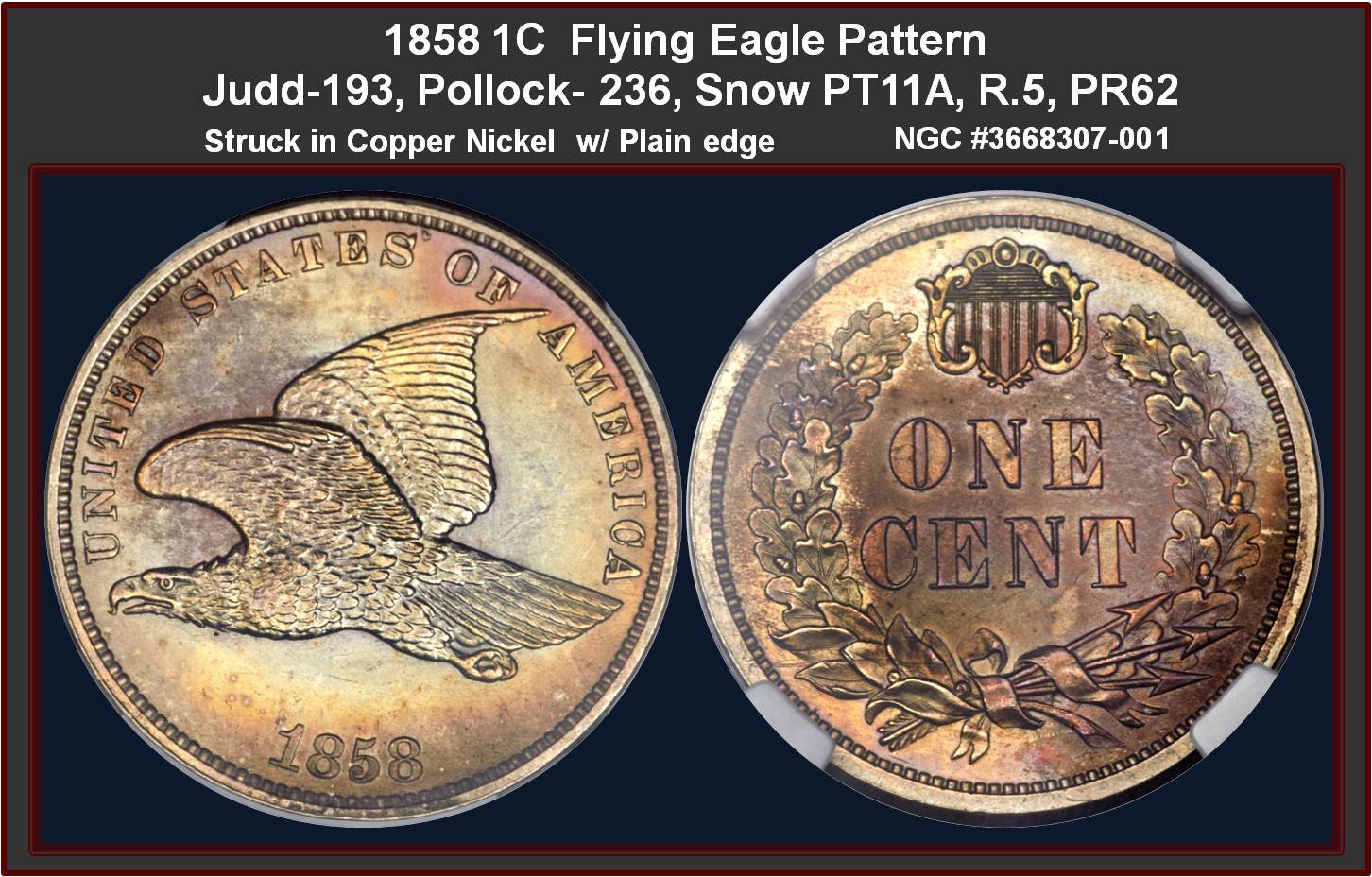
1859 1c Flying Eagle
Judd-193, Pollock-236, Snow-PT11a
Rarity:R 5, PF62
Struck in copper-nickel with a plain edge.
Obverse: Identical s the issued Small Letters 1858 Flying Eagle design,
Reverse: An oak wreath with a broad ornamental shield at top and a group of three arrows and an olive sprig bound at the bottom.
Blushes of rose-red and orange-gold enrich this satiny and fully struck specimen. The reverse is smooth while the obverse displays faint hairlines. Cameo effect with nice reflective fields
This is one of the 12 1858 1c pieces part of the pattern sets distributed to Congress.
Heritage 2013 April 24 - 28 CSNS US Coin Auction - Chicago / Lot #5318
|

|
|
View Coin
| J-202 |
United States
|
1C 1858 J-202
|
PCGS PF 62
|

1858 1C Flying Eagle Small
J-202, Pollock-245
Rarity: R.5
Eagle Eye Photo Seal.
Struck in copper-nickel with a plain edge.
Obverse: The hook-necked (or Skinny) eagle design (usually attributed to Longacre)
Reverse: a simple laurel wreath with "ONE CENT" in the center. This piece has clusters of five leaves (Pollock-245) vs P-246 with six leaves and a bit scarcer.
Rich golden coloring with the fields nicely mirrored. A few minor specks limits the grade.
This is one of the 12 1858 1c pieces part of the pattern sets distributed to Congress
|

|
|
View Coin
| J-203 |
United States
|
1C 1858 J-203
|
PCGS PF 62
|
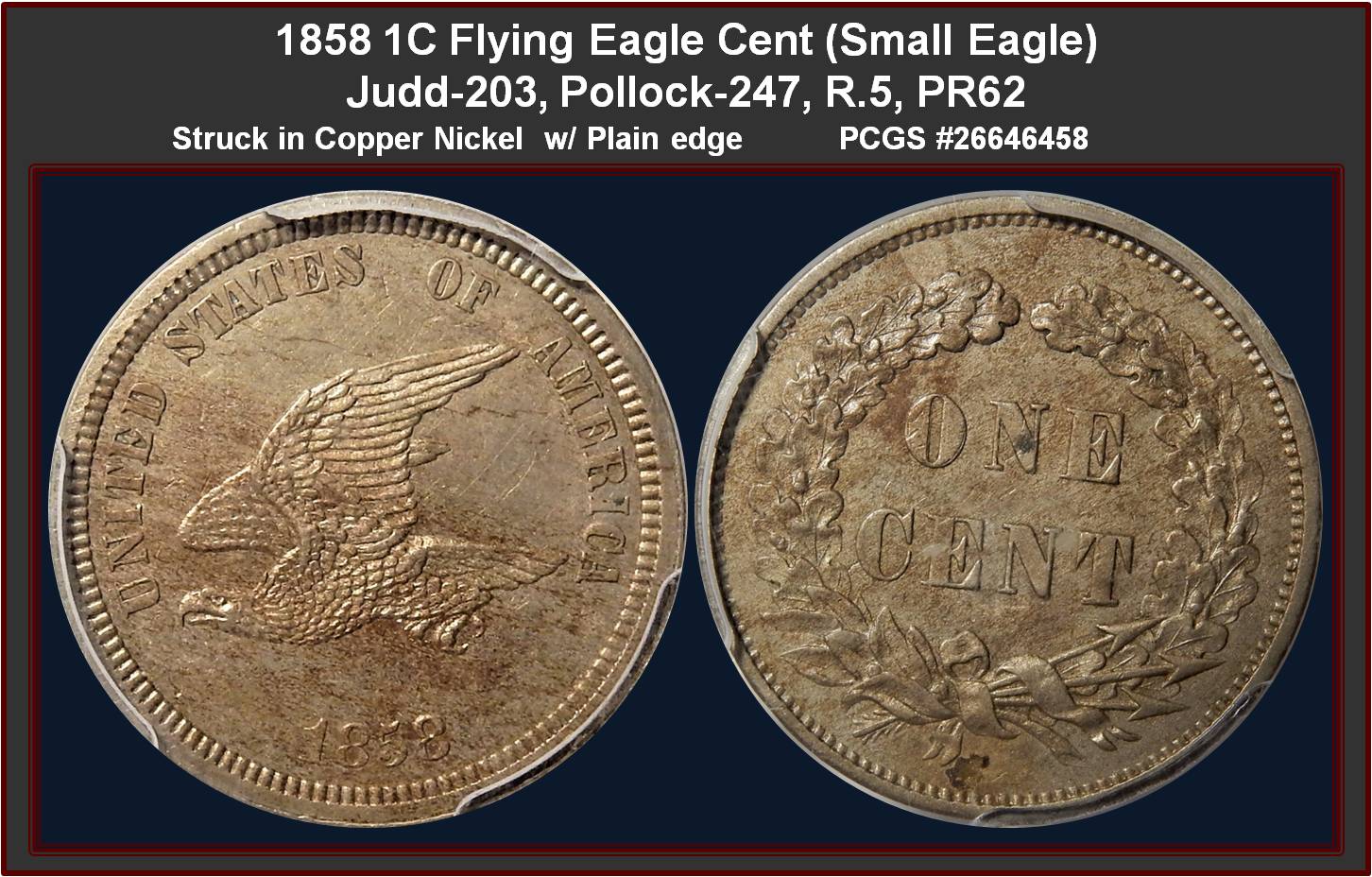
1858 Indian One Cent
Judd-203, Pollock-247
Rarity: R.5; PR62
Struck in copper-nickel with a plain edge
Obverse: The hook-necked small eagle flying left with tall wings.
Reverse: Oak wreath with the denomination "ONE CENT" in the center an olive sprig and a group of three arrows are wrapped into the bottom of the wreath.
Comment::
This is one of the 12 1858 1c pieces part of the pattern sets distributed to Congress
Provenance/Appearances:
Private Sale Feb 2013 ( No other appearance found)
|

|
|
View Coin
| J-204 |
United States
|
1C 1858 J-204
|
PCGS PF 62
|

1858 1C Flying Eagle
Judd-204 Pollock-248
Rarity: R.5
Struck in copper-nickel with a plain edge
Obverse: The hook-necked (or Skinny) eagle design (usually attributed to Longacre)
Reverse: Oak wreath with the denomination "ONE CENT" in the center and paired with an ornamental shield at the top.
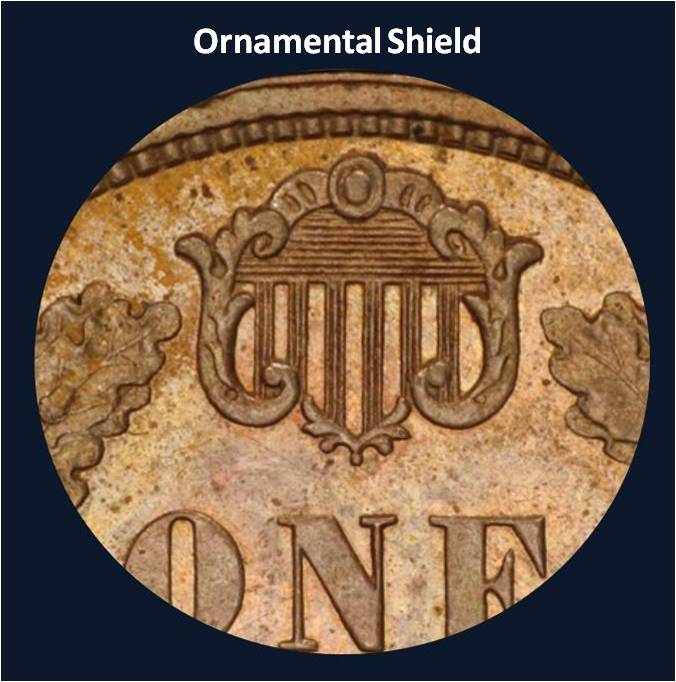
Overall very pleasing example
This is one of the 12 1858 1c pieces part of the pattern sets distributed to Congress
Counterfeits of this design exist and were mentioned by Paul Gilkes in the January 13, 1992 edition of Coin World
|

|
|
View Coin
| J-206 |
United States
|
1C 1858 J-206
|
PCGS PF 64
|

1858 1C Flying Eagle
Judd-206, Pollock-242, Snow-PT16
Rarity R.5, PF64
Struck in copper-nickel with a plain edge.
Obverse: Paquet's Small Eagle
Reverse: An agricultural wreath with the denomination "ONE CENT" in the center. The Low Leaves reverse. Slight hub doubling is evident on the reverse with the close E in ONE rehubbed with an open E.
This is one of the 12 1858 1c pieces part of the pattern sets distributed to Congress
Evenly mellowed and brown overall. At the right angle the mirrored fields still flash through the brown patina. Sharply struck throughout
Heritage 2017 January 4 - 9 FUN US Coins Auction - Fort Lauderdale / Lot #6493
|

|
|
View Coin
| J-208 |
United States
|
1C 1858 J-208
|
PCGS PF 64
|
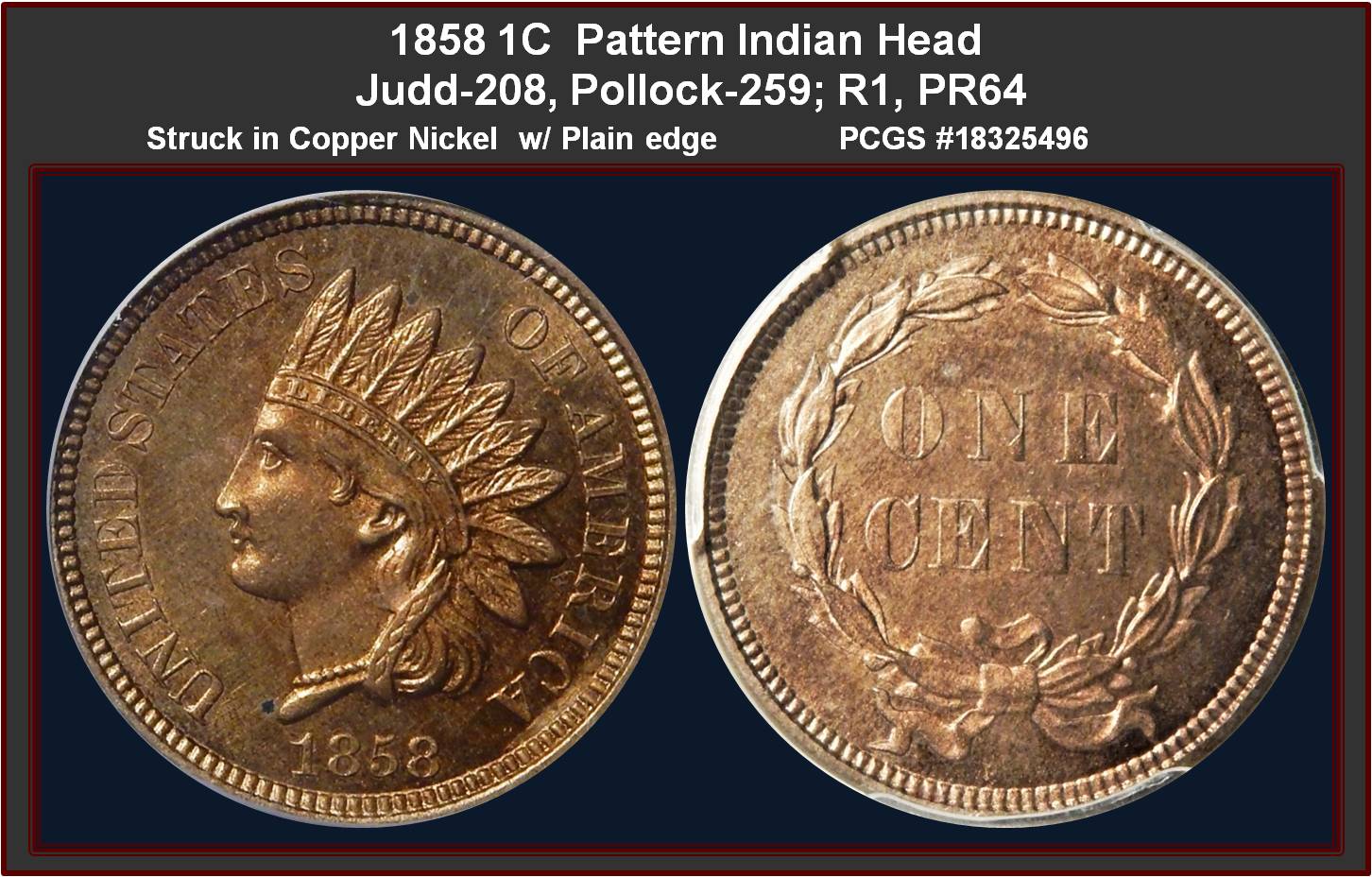
1858 1c Indian Head
Judd-208, Pollock-259
Rarity: R1. PF64
Struck in copper-nickel with a plain edge.
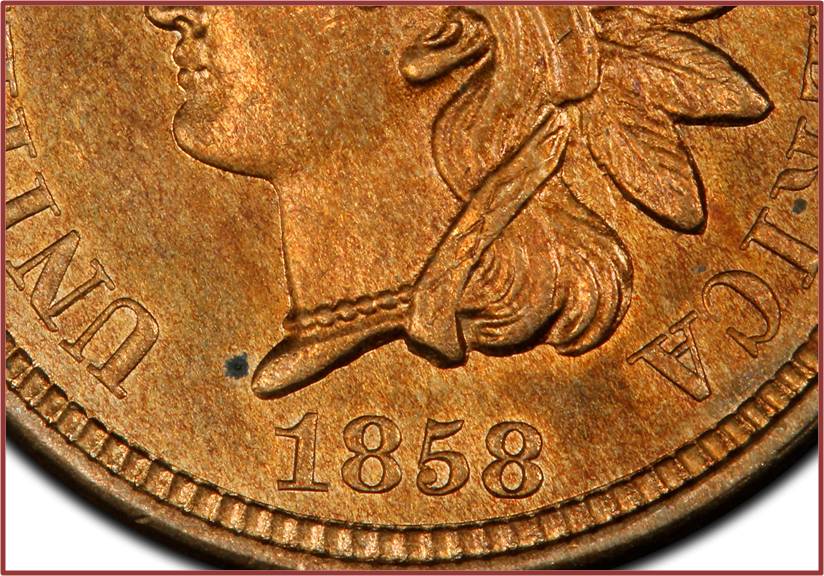 Obverse: Features the Indian design with Rounded Bust used to strike regular issue Cents from 1860 through early 1864. This is the Pollock/Snow subvariety with a centered date. Obverse: Features the Indian design with Rounded Bust used to strike regular issue Cents from 1860 through early 1864. This is the Pollock/Snow subvariety with a centered date.
Reverse: a laurel wreath with five leaf clusters surrounding “ONE CENT” in the center.
Sharp-to-full in strike, this bold-looking, reddish-tan example is kept from full Gem status by only a few wispy obverse carbon flecks. Popular pattern type!
Pedigree: From the G. Edward Reahl, Jr. M.D. Collection, Part II.
Stack's Bowers - The January 2011 Tampa Bay Rarities Sale Lot #1264
|

|
|
View Coin
| J-211 |
United States
|
1C 1858 J-211
|
PCGS PF 64
|

1858 Indian Cent
Judd-211, Pollock-262
Rarity:R.4, Eagle Eye photo seal Endorsed
Struck in Copper Nickel with Plain Edge
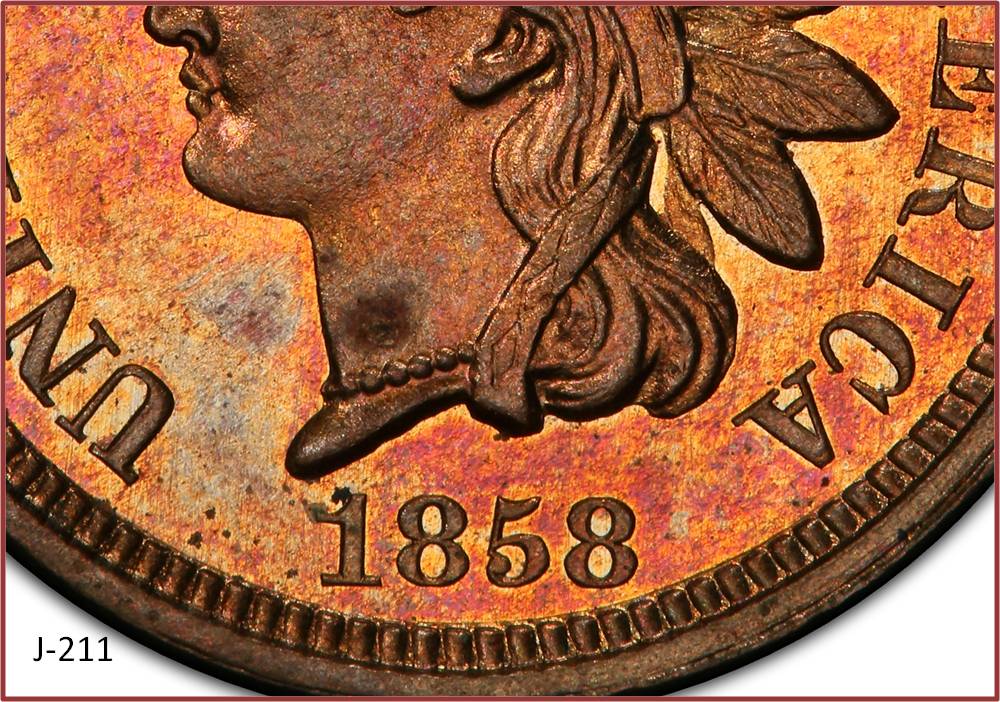 Obverse: Similar to the issued Indian cent, but is dated 1858. This is the centered date, broad bust point variant P-262 Obverse: Similar to the issued Indian cent, but is dated 1858. This is the centered date, broad bust point variant P-262
Reverse: Oak wreath with denomination "ONE CENT" in the center and 3 arrows tied off with olive Sprig at the bottom.
Provenance/Appearance:
Private transaction with Rick Snow of Eagle Eye Numismatics Sept 2020
|

|
|
View Coin
| J-212 |
United States
|
1C 1858 J-212
|
PCGS PF 62
|

1858 1C Indian Head
Judd-212, Pollock-263, Snow-PT25,
RARITY: R.4,
PR62 Cameo W/ EAGLE EYE PHOTO SEAL.
Struck in copper-nickel with a plain edge
Obverse: Indian Bust same as used to coin regular issues from 1860 on, with a centered date.
Reverse: Oak wreath with denomination ONE CENT in center and a ornamental shield at top and 3 arrows and olive sprig tied at the bottom
Nicely reflective surfaces with traces of golden red color and frosted devices
This coin was part of a 12 coin set of transitional patterns struck as a replacement for the Flying Eagle cent.
|

|
|
View Coin
| J-213 |
United States
|
1C 1858 J-213
|
PCGS PF 64
|

1858 1C Indian
Judd-213, Pollock 252 Low date Variety
Rarity:High R6 - Low R7, PR64
Struck in copper-nickel with plain edge
Obverse: Indian Head with a pointed bust truncation, faces left, with the date below and the legend UNITED STATES OF AMERICA around the periphery (the adopted obverse for the Indian Head cent of 1859.)
Reverse: denomination ONE CENT within a wreath of corn, wheat, cotton, and tobacco leaves with the ribbon tips distant from the wreath. This variant the leaft that is closest to the C to about even with the base of the C 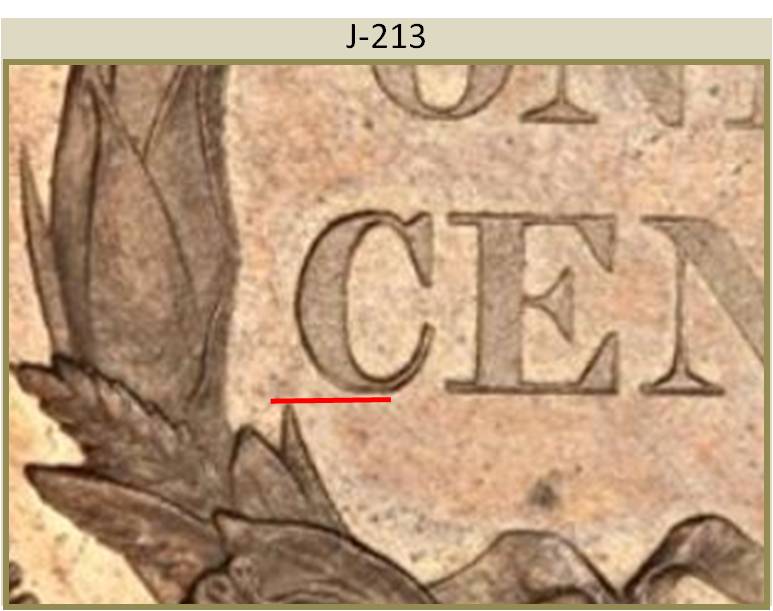
the J-213 is represented by 4 different die marriages, which gives it an overall rating of R-5 in the Judd reference book. The Low Date varieties are scarcer, with perhaps fewer as High R-6 < 18 pieces .
This coin was part of a 12 coin set of transitional patterns struck as a replacement for the Flying Eagle cent. Like the other patterns in the set, there were combinations of dies used, this one with a Low Date, there are two Pollock numbers assigned to these, with a combined estimate of about 18 known.
The reflective surfaces can be seen in the light, and the strike is bold throughout, especially on the reverse which is known to be weakly struck at times.
The Regency Auction XIX December 2016
|

|
|
View Coin
| J-226 |
United States
|
1C 1859 J-226
|
PCGS PF 64
|

1859 1C Indian
Judd-226, Pollock-270, Snow-PT2
Rarity: High R.6, PR64, CAC Endorsed
Ex: Simpson.
Struck in copper-nickel with a plain edge.
Obverse: The same Indian Bust as the issued 1859 cent with the pointed bust truncation.
Reverse: Resembles the issued cent reverse of 1860 with the oak wreath and "ONE CENT" denomination in the center but lacks a shield at the top.
Comment:
This obverse / reverse pairing is scarcer than most Indian cent patterns from this era with fewer than a dozen pieces known. This is a deeply mirrored example whose obverse is several shades lighter than the reddish-tinged reverse. Light carbon specking is scattered over each side.
Interesting that this is a seldom seen pattern especially since it viewed as High R.6 Rarity with some 20 pieces extant
Provenance/Appearances:
From the Bob Simpson Sale Part 4 Heritage Feb 2021 Dallas Signature Auction /Lot #3148
Superior Jun 1977 (Dr. Walter Lee Crouch Collection) / Lot #82
|

|
|
View Coin
| J-227 |
United States
|
1C 1859 J-227
|
NGC PF 63
|
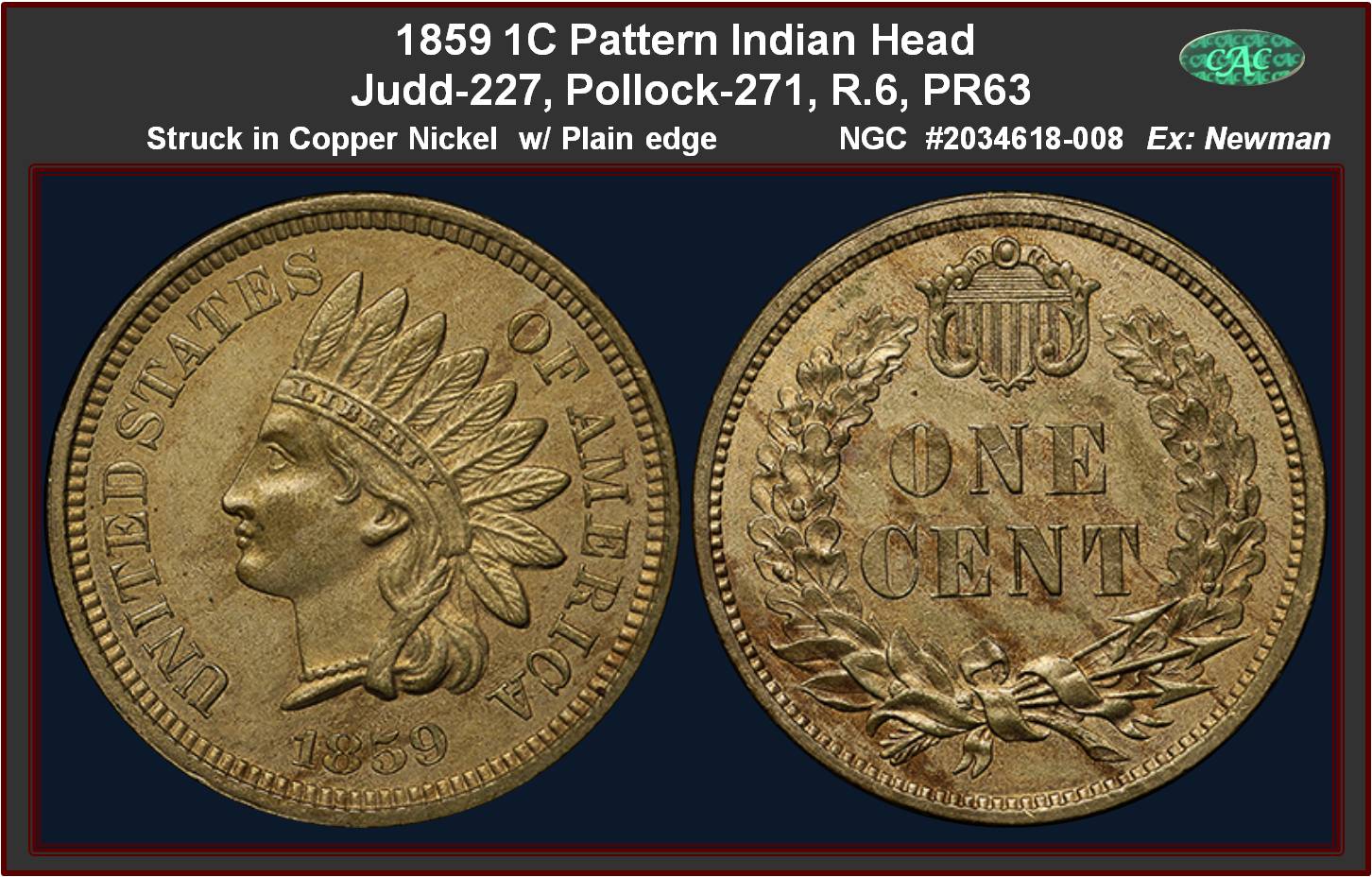
1859 Indian Cent
Judd-227, Pollock-271
Rarity Low R.6, CAC.endorsed
Ex: The Eric P. Newman Collection
Struck in copper-nickel with a plain edge
Obverse: The same Indian Bust as the issued 1859 cent with the pointed bust truncation.
Reverse: Resembles the issued cent reverse of 1860 with the oak wreath and "ONE CENT" denomination in the center but with a broad ornamental shield has been added at the top.
Comment:
This attractive Select specimen exhibits sharply detailed design elements and matte like surfaces on the obverse, with just a few hints of reflectivity. The reverse is equally sharp, with a lighter, satiny appearance overall. Areas of light brown toning mix with the original orange-red. The overall effect is quite appealing
A side note per Heritage catalog was an early auction appearance was in lot 108 of the Lorin G. Parmelee Collection (New York Coin & Stamp), where it was listed in the pattern section along with an example of Judd-228:
"1859 Cents: Indian heads (adopted type). R oak wreath: garnished and plain shields: former rare: cop-nickel: uncirc.; 3 pcs."
From the cataloger's comments, Judd-227 must have been a more challenging issue in 1890 than it is today. Perhaps several examples surfaced in William Woodin's hoard in 1910.
Provenance/Appearance:
From The Eric P. Newman Collection Heritage April 2013 CSNS Signature Auction - Chicago / Lot #3923; Prior "Colonel" E.H.R. Green; Green Estate; Partnership of Eric P. Newman / B.G. Johnson d.b.a. St. Louis Stamp & Coin Co.; Eric P. Newman @ $12.50; Eric P. Newman Numismatic Education Society.
.
|

|
|
View Coin
| J-228 |
United States
|
1C 1859 J-228
|
PCGS MS 66
|
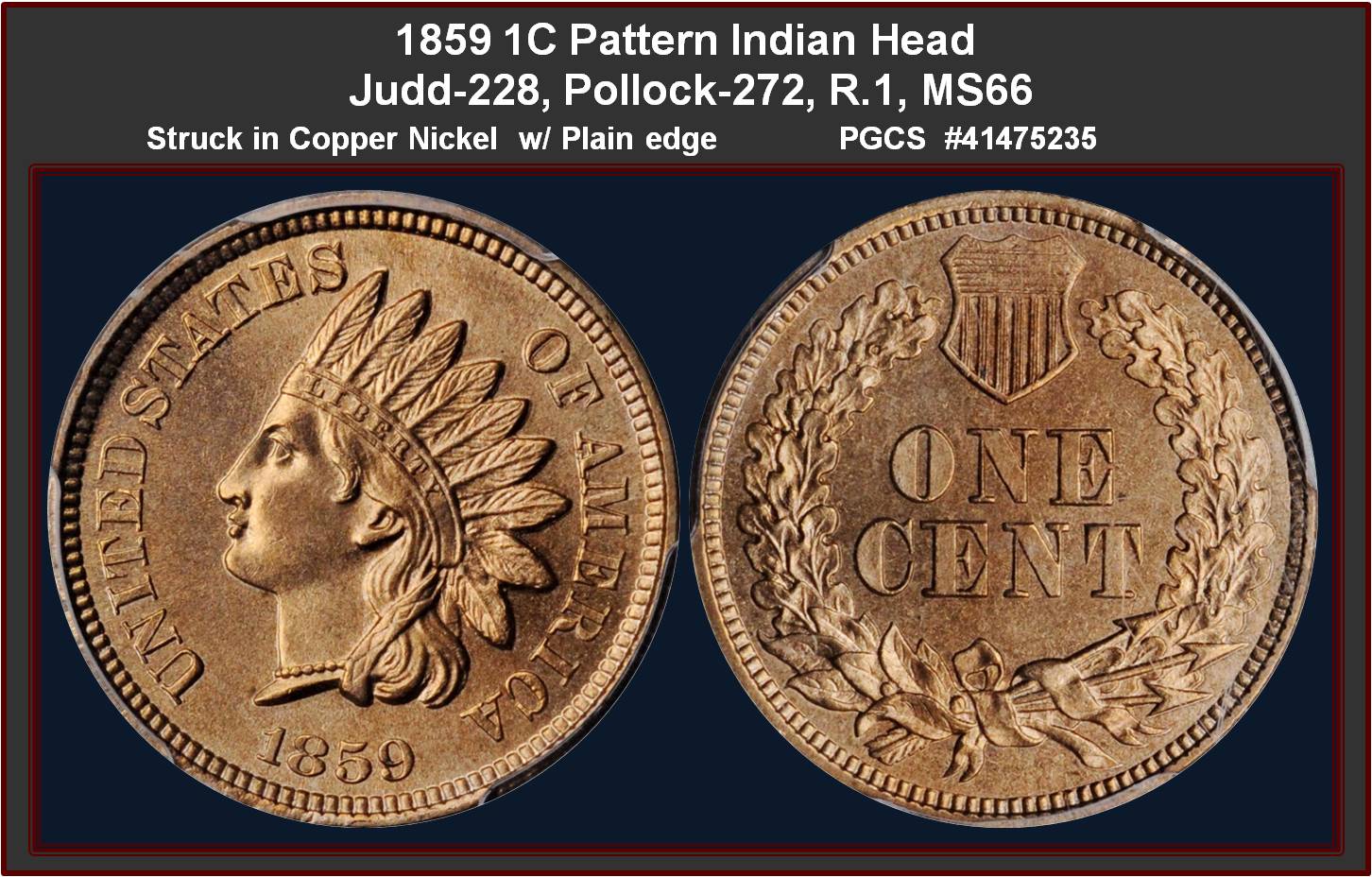
1859 Indian One Cent
Judd-228, Pollock-272.
Rarity: R.1, PR66
Struck in Copper-Nickel with Plain Edge.
Obverse: The same Indian Bust as the issued 1859 cent with the pointed bust truncation.
Reverse: Again this resembles the issued cent reverse of 1860 with the oak wreath and "ONE CENT" denomination the in the center and teh 3 arrows and Olive Sprig at the bottom but this one includes the Formal Federal shield at the top as used from 1860 on.
Comment:
This mint state example displays blended shades of golden-bronze adorn each side of this superior Gem, accented by tremendous proof like reflectivity in the fields. This is a popular transitional issue, circulation strike survivors of which are almost exclusively in Mint State, as this one. This fact suggests that these coins were distributed to collectors, possibly in trade for items to grow the Mint Cabinet collection. This example is among the finest survivors known.
Provenance/Appearance:
Stacks and Bowers March 2021 Featuring the Fairmont Collection / Lot 5601; Prior: Ex Bowers and Ruddy Galleries, privately circa 1980
|

|
|
View Coin
| J-299 |
United States
|
1C 1863 J-299 THIN
|
NGC PF 65 BN
|

1859 1C Indian
Judd-299, Pollock-359, Snow-PT1a,
Rarity: R.3, P65BN
Struck in bronze on a thin planchet with a plain edge
This piece is another transitional variety Indian head piece; similar to the 1864 No L bronze cent but dated 1863. In this time period all regular issue cents were of copper-nickel. The dies exhibit medallic alignment, as usual for Judd-299.
Heritage auction described this cent as "a razor-sharp Gem whose deeply patinated surfaces display olive-green and ruby-red undertones. Immaculate save for a small spot above the 6 in the date and a few strike-throughs on the obverse rim between 8 and 9 o'clock."
Heritage Sept 2011 Long Beach / Lot #4164
|

|
|
View Coin
| J-605 |
United States
|
1C 1868 J-605
|
PCGS PF 63
|
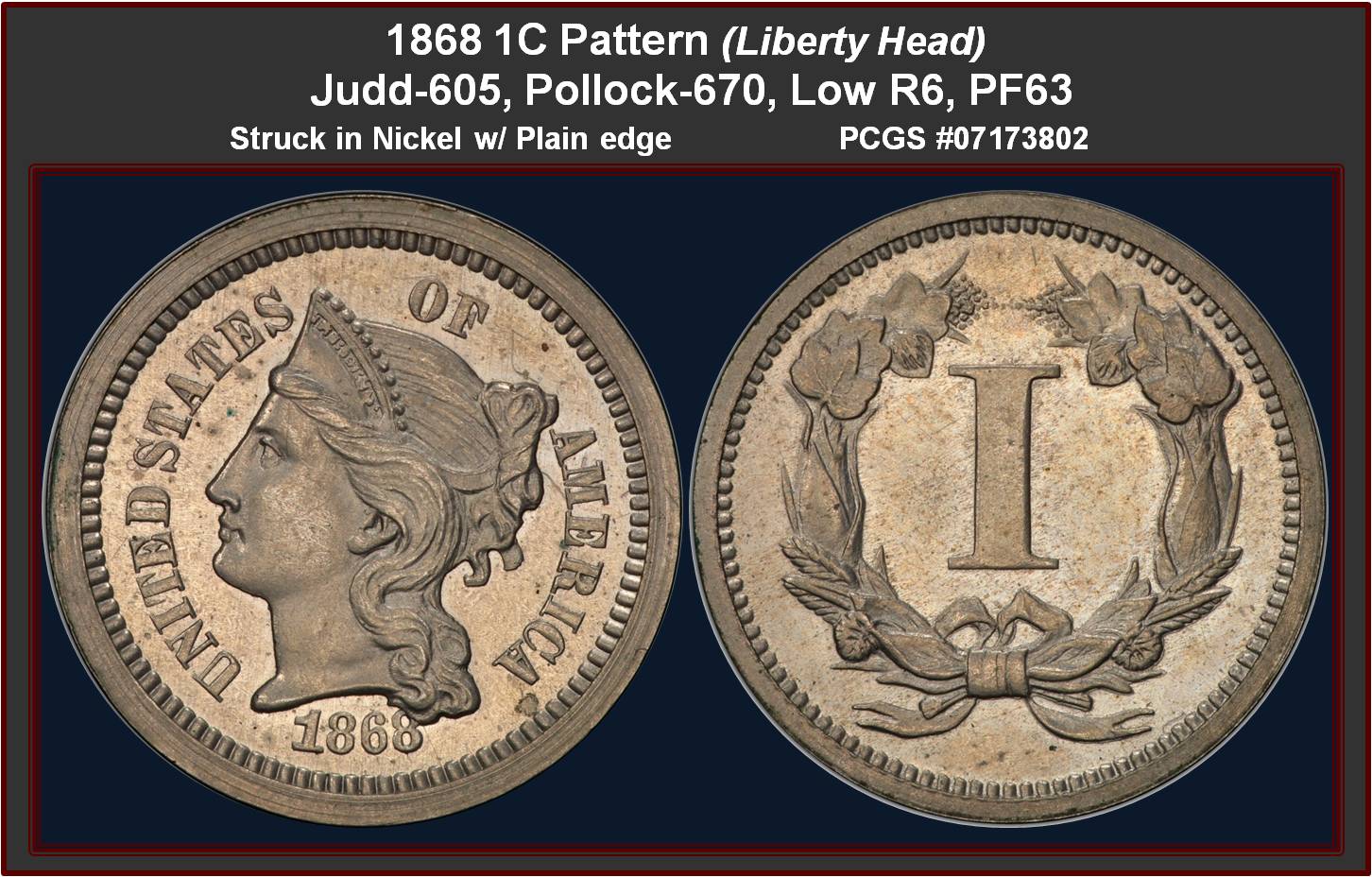
1868 1C
Judd-605, Pollock-670
Rarity: Low R.6, PF63
Struck in nickel with a plain edge.
Obverse: The design closely resembles the contemporary three cent nickel with the head of liberty wearing a cornet.
Reverse: Similar to the 3CN however only a single pillar represents the denomination within a open wreath of wheat, cotton, corn and tobacco.
Comment:
The obverse 2nd 8 in the date encroaches into the curls of Liberty. The date appears to be modified in J-608 with a more centered date away from the curls.
Light gray patina covers both sides with a few tiny flyspecks on the obverse.
Provenance/Appearance:
From Heritage Oct 2016 Dallas Signature Auction / Lot #3974
|

|
|
View Coin
| J-606 |
United States
|
1C 1868 J-606
|
NGC PF 62 BN
|

1868 1C Cent
Judd-606, Pollock-671, Snow-PT2b
Rarity: Low R.7, PR62 BN
Struck In copper with plain edge
Obverse: The obverse greatly resembles the three cent nickel design were Liberty is wearing a coronet inscribed LIBERTY and the coin is smaller, The date 1868 is touching Liberty's lowest curl and UNITED STATES OF AMERICA around the periphery.
Reverse: The reverse has a large Roman numeral I enclosed within a wreath of wheat, corn, tobacco, and cotton.
Comment: This piece displays deep burnt-brown patina with subtle texture in the fields. The strike is sharply struck and bold, and there are few signs of marks.
This piece was one of the small denomination pieces struck in trial as part of the 3 piece set of ,1 3, and 5 cents all in copper. USpatterns.com states only 2 or 3 dozen sets (J605 type) were believed struck in nickel and just a half dozen sets (J606 type) in copper.
Provenance/Appearance:
From The Toro Collection 2021 Heritage Oct 4 The Toro Collection US Coins Showcase Auction / Lot #45539; Prior From The Jones Beach Collection , Heritage Jan 2007 Orlando (FUN) Signature Auction / Lot #1349
|

|
|
View Coin
| J-608 |
United States
|
1C 1868 J-608
|
NGC PF 66
|

1868 1C
Judd-608, Pollock-673
Rarity: R.4, PR66 CAC Endorsed
Struck in nickel with a plain edge.
.Obverse: The design closely resembles the contemporary three cent nickel
Reverse: A single pillar represents the denomination within the wreath, and the ribbon ends are more prominent.
Comment: This is the Pollock Variety 2 with the date centered over a denticle.
A sharply struck and essentially brilliant Premium Gem with flashy fields and an undisturbed appearance.
USpattern.com site shares the following information
In this year, the mint began testing of a uniformly designed minor set containing the one cent, 3 cent and 5 cent design struck in nickel.
Two such design sets were prepared. One such set, contained J608/P673, J618/P687 and J633/P704-P705. It earliest sales occurrence appears to be Mason & Co's 9/1869 Thorn sale.
The other contained J605/P670, J615/P680 and J623/P692 or the wide planchet J624/P693. Its earliest sales occurrence was Mason & Co's 10/1869 J. C. Randall sale.
Both sets were sold to collectors for $9 per Ed Cogan's 1/1871 sale lot 303. Some sets may have had mixed coinage from among the 6-7 pieces available.
Provenance/Appearances:
Private sale with Rick Snow Feb 2018 ; Prior From The Martin L. Diffenbaucher, Jr. Collection Heritage Jan 2009 Orlando, FL FUN Auction / Lot #2022
================================
Small Denomination sets of 1868 and 1869

|

|
|
View Coin
| J-609 |
United States
|
1C 1868 J-609
|
PCGS PF 63 Brown
|
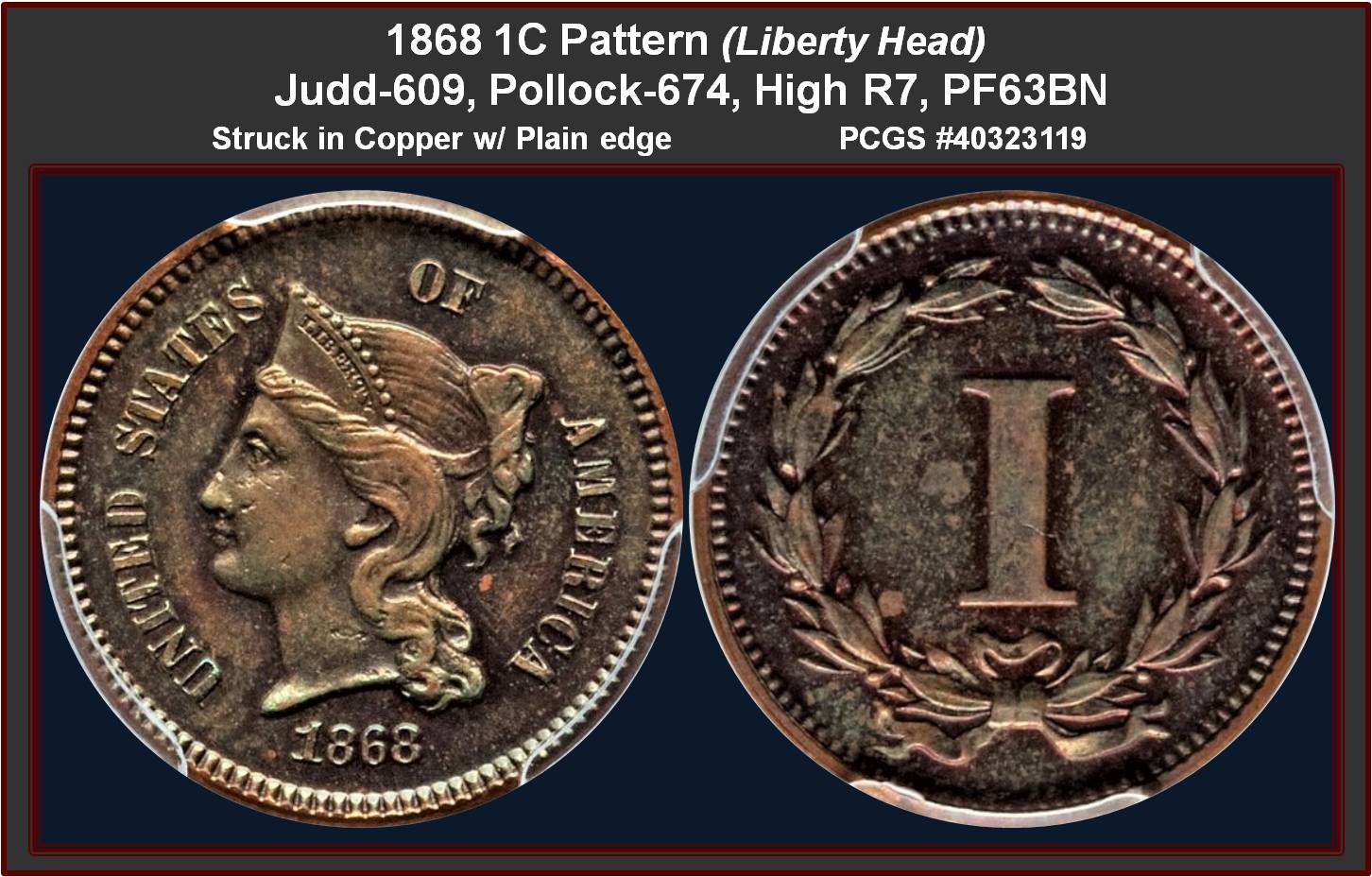
1868 1C
Judd-609, Pollock-674
Rarity: High R.7, PR63 BN
Ex: Simpson.
Struck in copper with a plain edge.
Obverse: The design closely resembles that of the three cent nickel
Reverse: Closely resembles that of the three cent nickel except that the Roman numeral I instead of III is within the wreath. RI in AMERICA touch at the bases, and the base of the 1 in the date is repunched.
Comment:
These patterns were issued in sets along with the 3 cent (Judd-618-Judd-620) and 5 cent (Judd-633-Judd-634). All copper strikes seen are of the High Date variant, unlike the nickel patterns that are found in both High and Centered Date varieties. Only a half dozen pieces are believed known. The surfaces on this piece have mellowed to an attractive iridescence. Planchet flakes are located on the neck of Liberty, the face, and another on the reverse to the left of the I in the denomination.
Provenance/Appearances:
From The Bob R. Simpson Collection, Heritage Sept 2020 Important Selections, Part I / Lot #10225, Prior Ira & Larry Goldberg Auctions May 2003 /Lot #592
Plate Coin for PCGS Coinfacts for Type J609
|

|
|
View Coin
| J-610 |
United States
|
1C 1868 J-610
|
PCGS PF 65
|

1868 1C
Judd-610, Pollock-675, Snow-PT4b
Rarity: Low R.7; PR65 CAC Endorsed
Ex: Simpson.
Struck in nickel with a plain edge
Description: This is the so-called 1868 large cent. These pieces were struck with the obverse and reverse design used to produce regular issue 1843-1857 large cents.
Comment:
Seven examples are known in nickel and about a dozen or so are known in copper. The hardness of the nickel alloy is evident on this piece. The date area is noticeably incomplete, and slight softness occurs on the wreath. Bright and satiny, the surfaces are mostly untoned and show a fine speckling of carbon over each side.
It is not known for sure why the 1868 large cent were struck but it has been speculated that it probably were made as numismatic delicacies in an time frame that the Philadelphia Mint was producing many different die combinations and off-metal strikings. In this time frame some of the products from this effort were made available to numismatists but a far larger number were filtered through favored mint officials and insiders, who marketed them to the likes of Mr. John W. Haseltine (a Philadelphia dealer who) or Mr. W. Elliot Woodward (Roxbury, MA, dealer of high renown and expertise)
Pollock made a note on Q.David Bowers writings "They were probably struck for collectors in the genre of the 1913 Nickel Liberty Head Nickel, 1884 and 1885 trade dollars and Clasee II and III 1804 dollars" Wow - if Ken Bressett, editor of the Guide Book, ever listed this piece as they published those just mentioned what a home run I would have. Oh well. .
Provenance:
Ex Bob Simpson, Heritage April 2021 Central States / Lot #4212., prior Heritage FUN Signature, 1/2004 / lot 8440
|

|
|
View Coin
| J-666 |
United States
|
1C 1869 J-666
|
NGC PF 66 CAMEO
|

1869 1C
Judd-666, Pollock-741,
Rarity: Low R.6, PF66CAM CAC Endorsed
Struck in nickel with a plain edge.
Obverse: The obverse exhibits a Liberty head facing left with the legend UNITED STATES OF AMERICA around the periphery and the date below. Liberty wears a coronet inscribed LIBERTY.
Reverse: A Roman numeral I is centered in a laurel wreath on the reverse.
Comment:
Judd-666 was struck from at least three obverse and two reverse dies, designated Pollock-741 through -743 by Andrew Pollock. This example represents Pollock-741, with the 9 in the date closer and under the curl, L in Liberty between 2nd and 3rd pearl and broad ribbon ends on the reverse.
The design elements of this Premium Gem are well-detailed, with just a touch of softness on the lower hair curls. Designated as a Cameo as the frosty devices exhibit definite elements of contrast with the deeply mirrored fields.
|

|
|
View Coin
| J-1665 |
United States
|
1C 1881 J-1665
|
PCGS PF 64
|

1881 1C barber Liberty head
Judd-1665, Pollock-1865
Rarity: High R.6, CAC Endorsed.
Ex: Simpson.
Struck in nickel with a plain edge.
Obverse: The motifs closely resemble those on the issued 1883 Liberty nickel where Liberty wears a coronet inscribed with LIBERTY i incused letters and behind are the heads of a wheat and cotton leaves and bolls.
however, unlike the Liberty head nickel of of 1883 the obverse stars are absent in favor of UNITED STATES OF AMERICA
Reverse: The Roman numeral I for the denomination within a wreath of cotton and corn .
Comment:
These designs were also used on the three cent (Judd-1668) and five cent (Judd-1671) designs of this year. Probably about two dozen examples of Judd-1665 are extant. This impressive Choice proof is sharply detailed throughout, with lightly marked surfaces that are blanketed in attractive shades of lavender-gray and sea-green toning.
Provenance/Appearances:
From the Bob Simpson Collection, Heritage April 2021 Central States Signature Auction / Lot #4300; prior Possible the Superior 2/4/1992 The Century Collection Sale piece /Lot #1967 (appears a couple of small diagnostics marks are common even with the low quality B&W internet image)
|

|
|
View Coin
| J-1666 |
United States
|
1C 1881 J-1666
|
PCGS PF 62 Brown
|

1881 1C Barber Liberty head
Judd-1666, Pollock-1866
Rarity: High R.6, PR62BN
Struck in Copper with a Plain Edge
Obverse: The motifs closely resemble those on the issued 1883 Liberty nickel where Liberty wears a coronet inscribed with LIBERTY i incused letters and behind are the heads of a wheat and cotton leaves and bolls.
however, unlike the Liberty head nickel of of 1883 the obverse stars are absent in favor of UNITED STATES OF AMERICA
Reverse: The Roman numeral I for the denomination within a wreath of cotton and corn .
Comment:
Medium golden brown with orange highlights. About a dozen examples are known. PCGS
These are of interest as with the 1868 1C, 3C and 5 C pattern versions that resemble the the dies of the 3 cent pieces. These Barber Head also use Roman numerals to depict the denomination (cents).
Provenance/Appearances:
Stacks Mar 2012 Baltimore Lot #7197
|

|
|
View Coin
| J-1721 |
United States
|
1C 1884 J-1721 LEMUS COLLECTION
|
NGC PF 64
|

1884 1C 'Holey' One Cent
Judd-1721, Pollock-1929
Rarity: R.5, PR64
Ex Lumus
Struck in nickel with a plain edge.
Obverse: The Eastman Johnson "holey cent" design. The planchet is holed at the center. The obverse has UNITED STATES OF AMERICA above and the date below, with no other design or ornament.
Reverse: Shows ONE CENT above with an inverted shield and wheat stalks below, within which the fields are open.
Comment:
The silver-gray surfaces demonstrate a modicum of field-device contrast, more so on the reverse than on the obverse. Some planchet irregularity in the form of light "waves" appears, possibly caused by the uneven pressure from striking caused by the center hole.
Both one cent and five cent patterns of this year feature the unusual Eastman Johnson "holey" design, apparently spurred by comments that the artist made in 1870, according to the Pollock reference. Some three to four dozen examples likely exist today.
Provenance/ Appearances:
Private Sale Dec 2014, From The Lemus Collection, Queller Family Collection Part Two, Heritage Jan 2009 FUN - Orlando, Fl / Lot 1953 and prior Stack's & Bowers Sept. 1985, The September Sale: United States Gold, Silver & Copper Coins /Lot 52 ($852)
================================================
Eastman Johnson Holey Patterns of 1884

|

|
|
View Coin
| J-1740 |
United States
|
1C 1885 J-1740
|
PCGS PF 65
|

1885 1C Eastman Johnson Design
Judd-1740, Pollock-1950
Rarity: High R.6, PR65
Ex: Simpson
Struck in silver with a plain edge.
Obverse: An annular (ring-shaped) pattern cent with a central perforation. The obverse has UNITED STATES OF AMERICA above with the date 1885/3 at the bottom of that side.
Reverse: ONE CENT is in large letters at the top with a small shield that is flanked by laurel sprigs below.
Comment:
Rick Snow reports about 10 pieces known, two of which are slightly worn. Delicately toned in reddish-gold and cobalt-blue patina, this Gem retains considerable mint brilliance. The underlying fields flash appreciably.
The digit 5 is over a 3, one of the few overdates among pattern coinage. The overdate feature is especially prominent, with a flat-top digit 3 below the final 5, giving a flat appearance to the normally curved top of the 5. This may suggest that dies for Johnson’s proposal were prepared in 1883.
Numerous die lines are visible on the obverse. The reverse has a crack from the outer border to the inner border, through the right side of N in ONE and seen other pieces
Wt. 54.35 grains.
Provenance/ Appearances:
From The Bob Simpson Collection Heritage Jan 2021 FUN Signature Auction / Lot #3272, Priors
- Stacks Oct 2003 ( 68th Anniversary Sale - Rothchild Collection) / Lot #1023;
- New Netherlands Jun 1970 61st sale (Jesse Taylor Estate) - REMARKABLE U. S. PATTERNS AND RELATED COINS From the Estate of Jesse M. Taylor, Buffalo, New York
- From Barney Bluestone’s 92nd auction, April 26, 1946, / Lot #1263. Plate ($250.00
|

|
|
View Coin
| J-1768 |
United States
|
1C 1896 J-1768
|
NGC PF 64 BN
|

1896 1C One Cent
Judd-1768, Pollock-1985A
RARITY: R.5/High R.7, PR64 BN CAC Endorsed
Struck in bronze with a plain edge.
Obverse:
Charles Barber design uses a Federal shield as its primary motif. The shield has 13 strips and the motto E PLURIUS UNIM above and date below. 2 crossed poles are behind the shield This 1896 pattern design features a large shield in the center of the obverse with crossed poles behind a Liberty Cap on one and Eagle on the other, A large ribbon across the center of the shield with “LIBERTY” inscribed.
Reverse: A large numeral 1 with “CENTS” in small letters below, surrounded by a curved olive sprig and UNITED STATES OF AMERICA around the perimeter.
Comment:
Two varieties are known for this pattern. This variant, Pollock-1985A discover by Harry Bass, shows the eagle pointing toward the open space to the right of the S in PLURIBUS and is considered rare.
The surfaces are even, chocolate-brown over each side, and there is slight high-point weakness
Provenance/ Appearance:
Private sale 9/2015; Prior Heritage June 2014- Long Beach / Lot #5039 ($3875)
|

|
|
View Coin
| J-1769 |
United States
|
1C 1896 J-1769
|
PCGS PF 62
|

1869 1C
Judd-1769, Pollock-1985
Rarity: High R.6 PF62 CAC Endorsed
Struck in aluminum with a plain edge.
Obverse: The obverse has a shield draped with a ribbon inscribed LIBERTY, poles in the background topped with a cap and an eagle. E PLURIBUS UNUM is placed at the top border with the date below, seven stars left and six right.
Reverse: The reverse has a single olive branch curved around 1 CENT with UNITED STATES OF AMERICA around.
Comment:
Fully brilliant and highly lustrous with satiny silver-gray surfaces with some minor blemishes of various types that limit the grade.
Bowers writes in 1999 “ This issue is quit significant as the latest date readily obtainable pattern of denomination. A long time ago in the 1950’s Bowers had acquired a cache of 1896 pattern cents and five-cent pieces from Robert K. Botsford, of Nescopek, PA, who obtained them from the estate of William H. Woodin (who lived not far away in Berwick, PA).
Called aluminum for sake of brevity, Pollock-1985 is actually found in many variations of the metal. In his United States Patterns and Related Issues, Andrew Pollock noted the following compositions for the type, none of which can be told from any of the others without extensive elemental analysis: (1). 100% aluminum; (2). 98.78% aluminum, .40% iron, .45% silicon, .37% cop¬ per; (3). 96.94% aluminum, .65% iron, .38% silicon, 2.03% copper; and (4). 96.74% aluminum, .45% iron, .31% silicon, 1.94% copper, .56% manganese
Provenance/ Appearances:
Private Sale 2/2020 priors:
-From The Jones Beach Collection, Heritage Jan 2007 Orlando, FL (FUN) / Lot #1629;
-From the William H. and Pauline M. Bonn Birth Year/Memorial Collection. Stacks and Bowers Aug 2012 Philadelphia ANA / Lot #12137;
- Also believe to be from Bowers and Merena Sept 1999 (The Collections of Emil Voigt, Sr. & Dr. Wallace Lee) /Lot #20
================================================
Aluminum Set

|

|
  
 | Loading… |
|